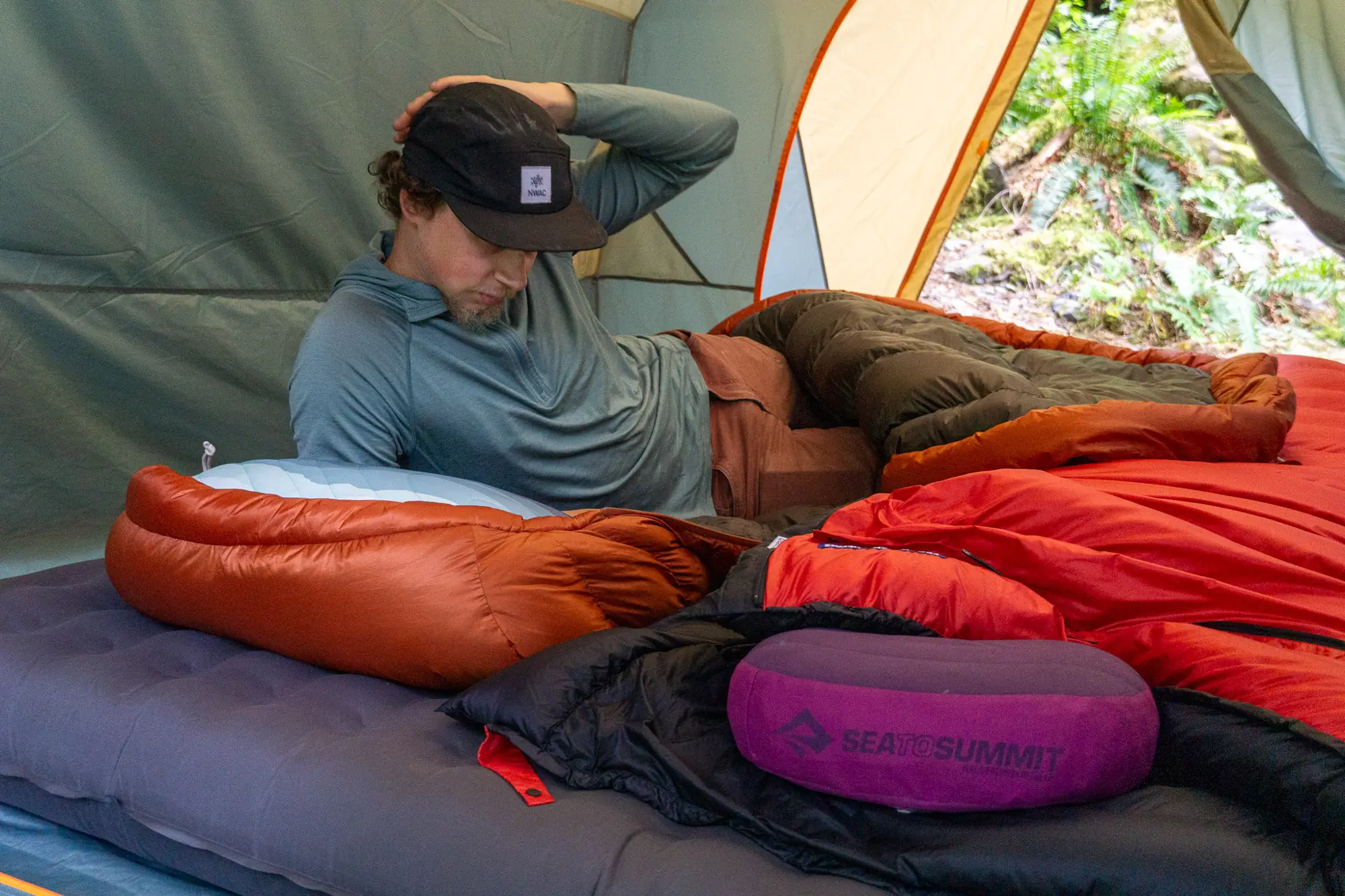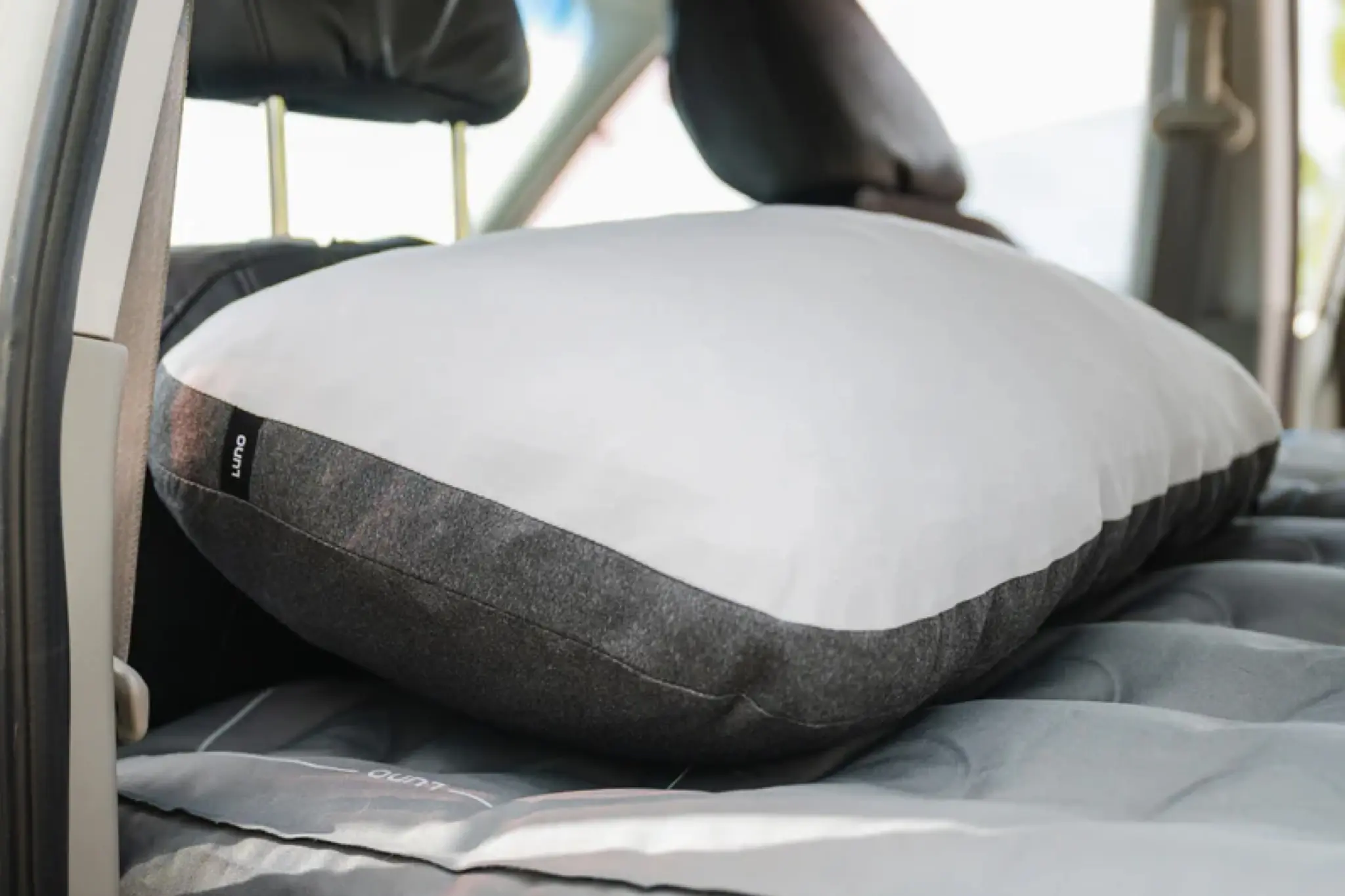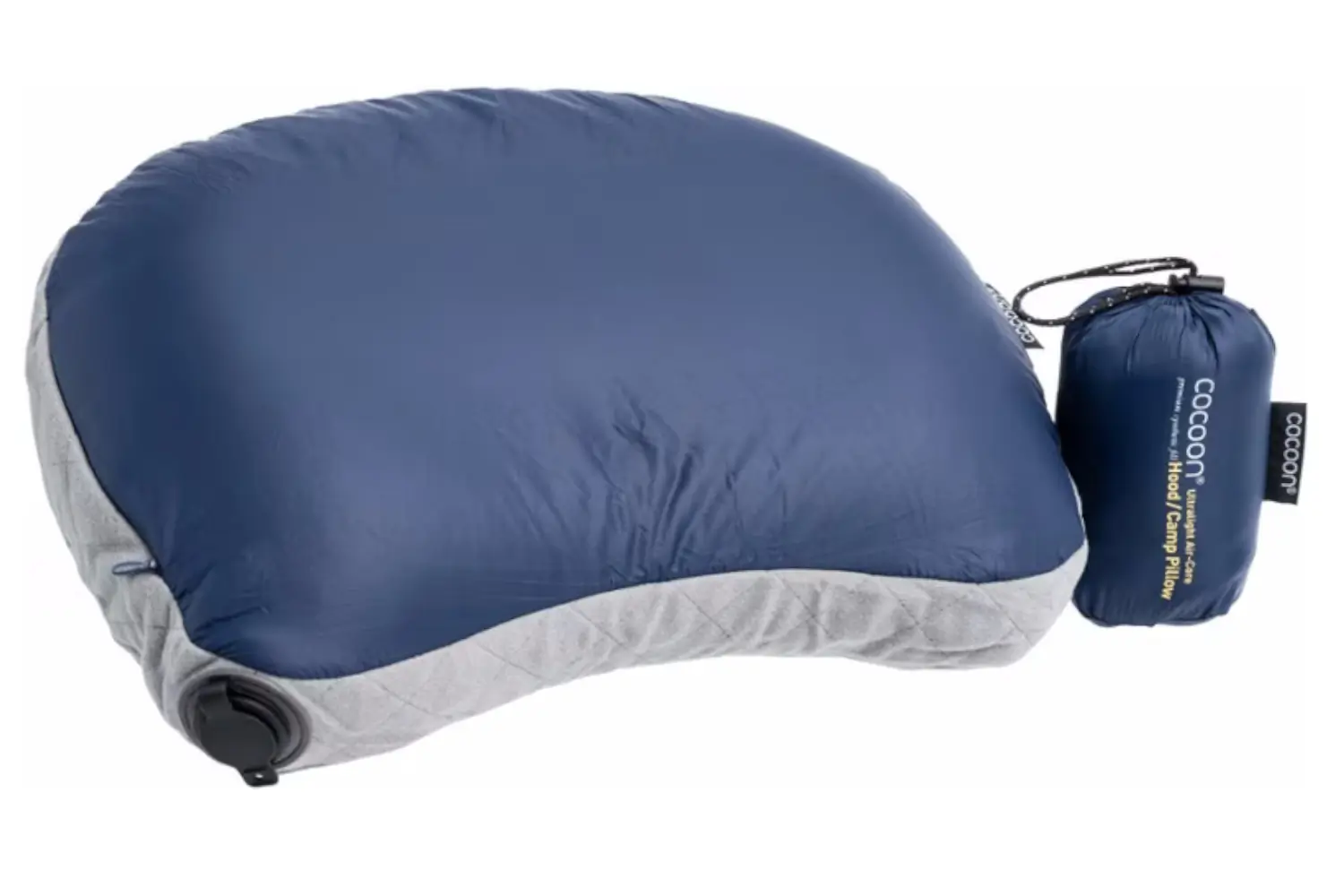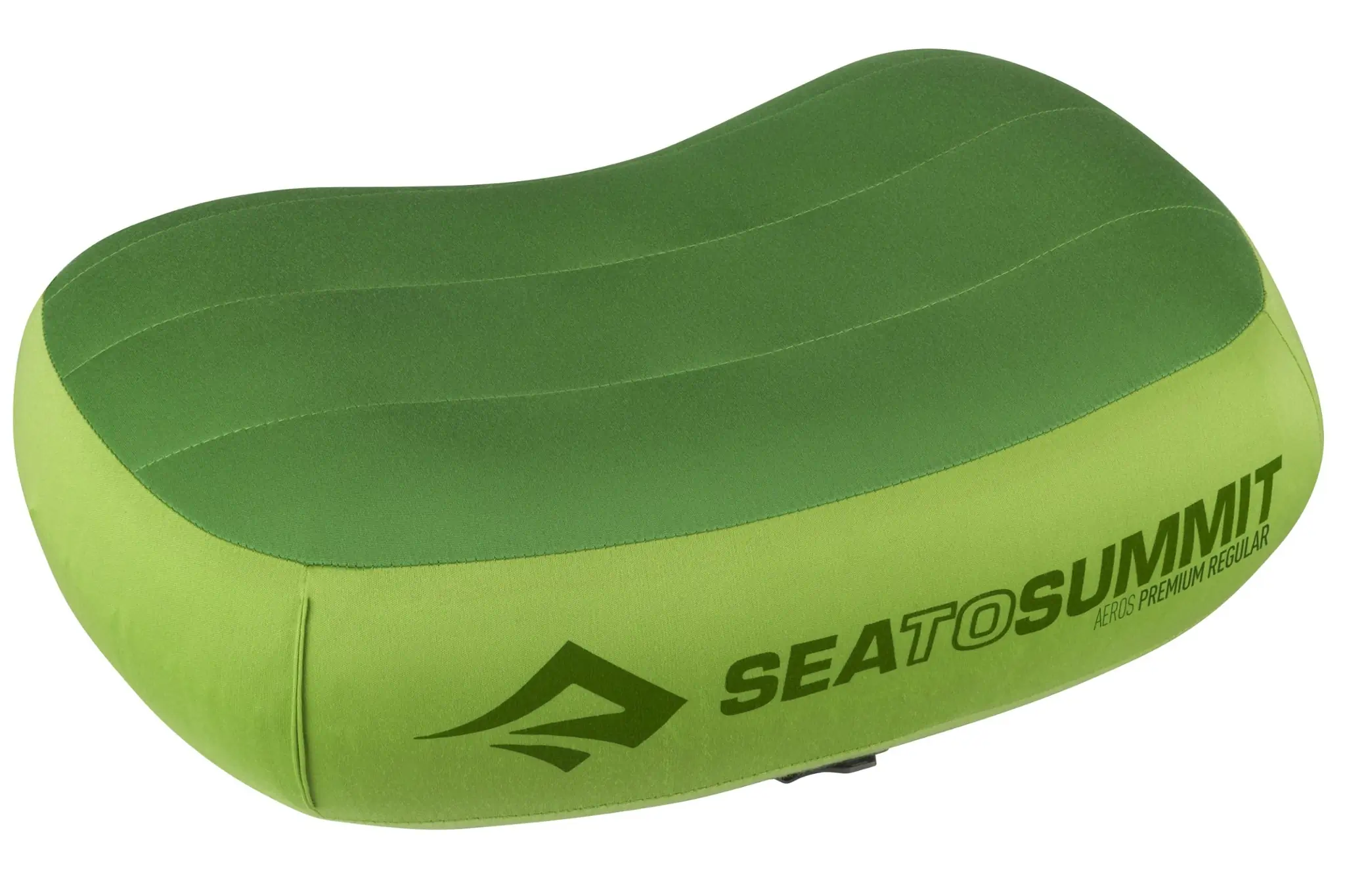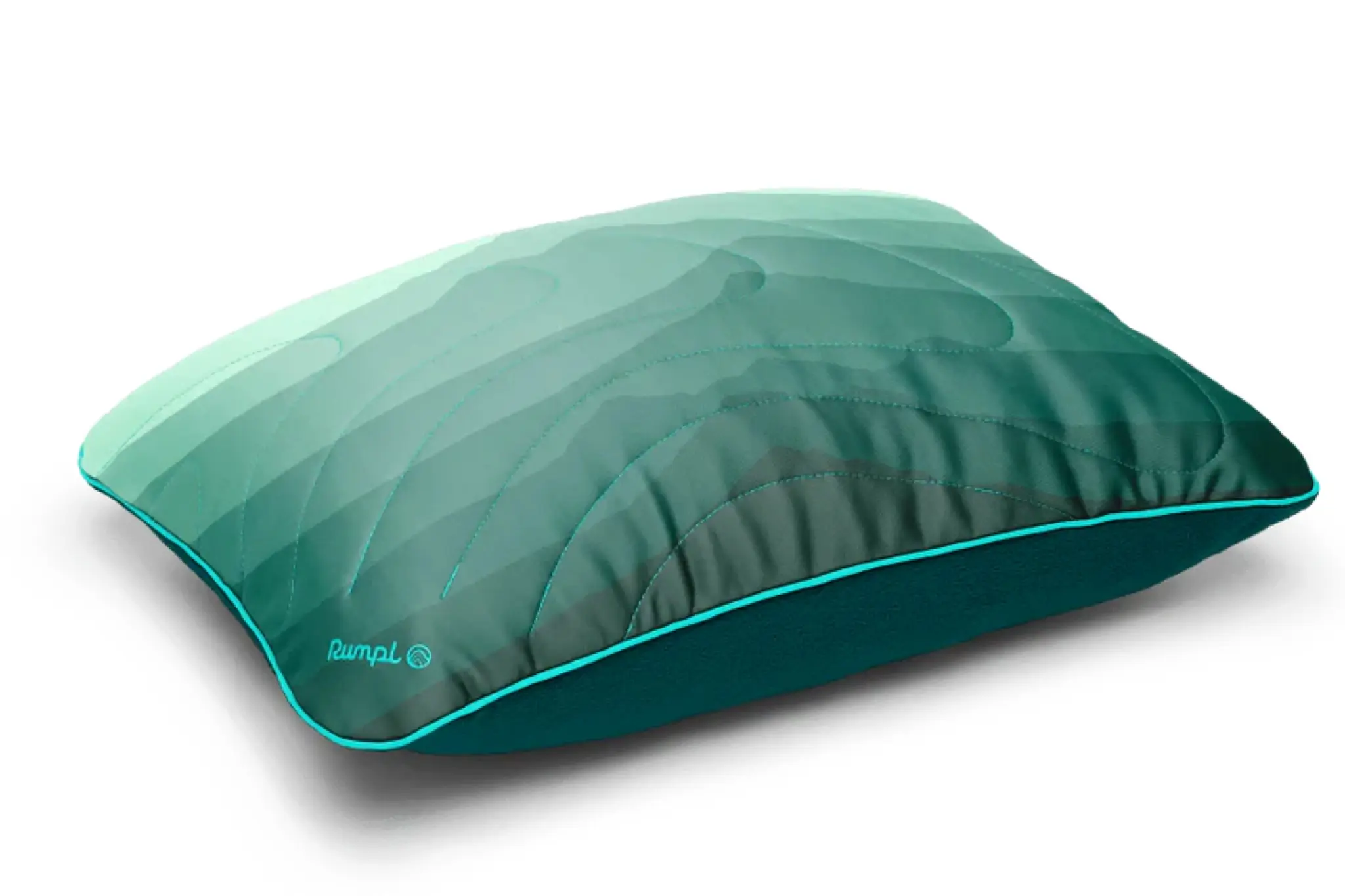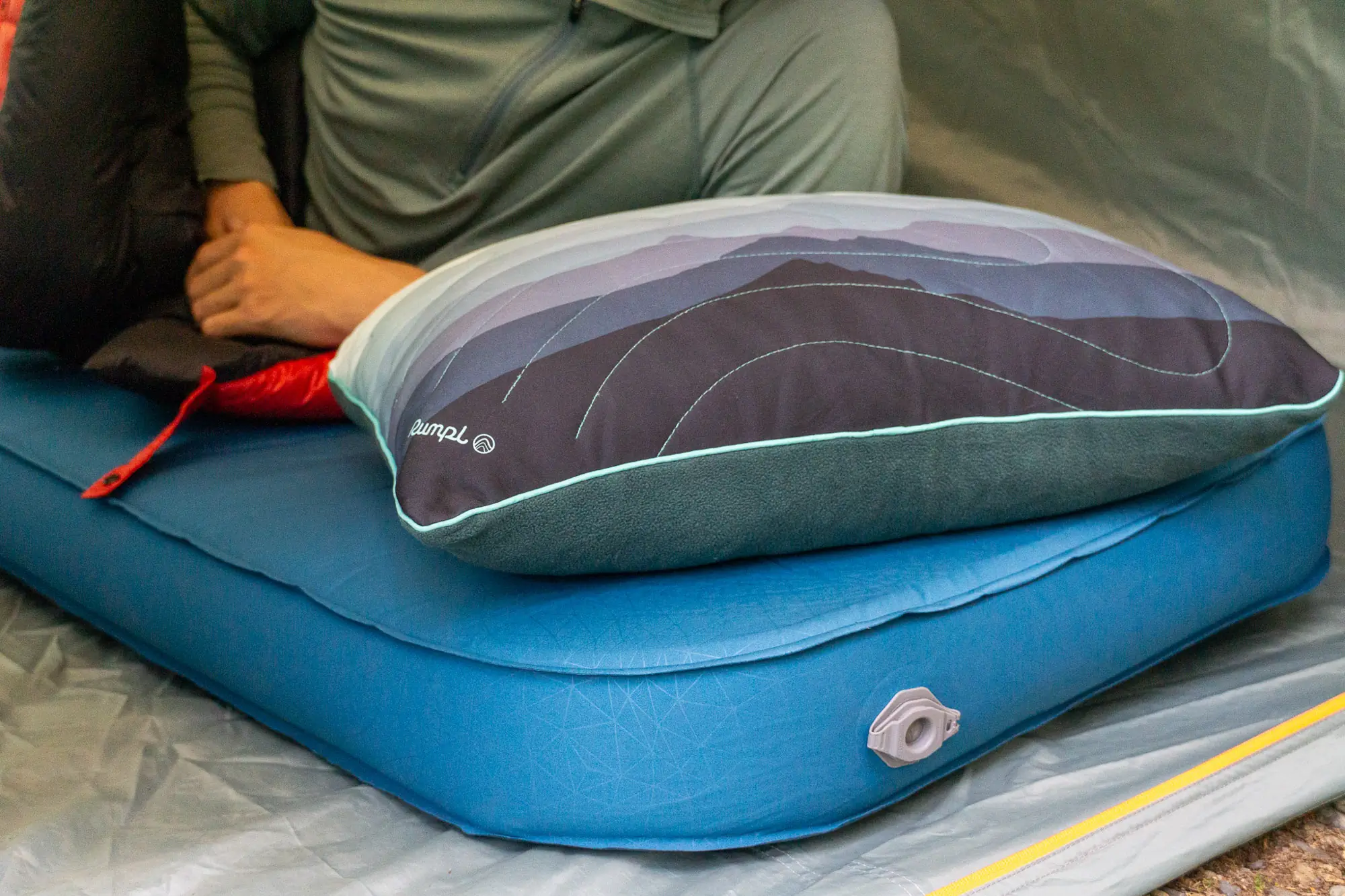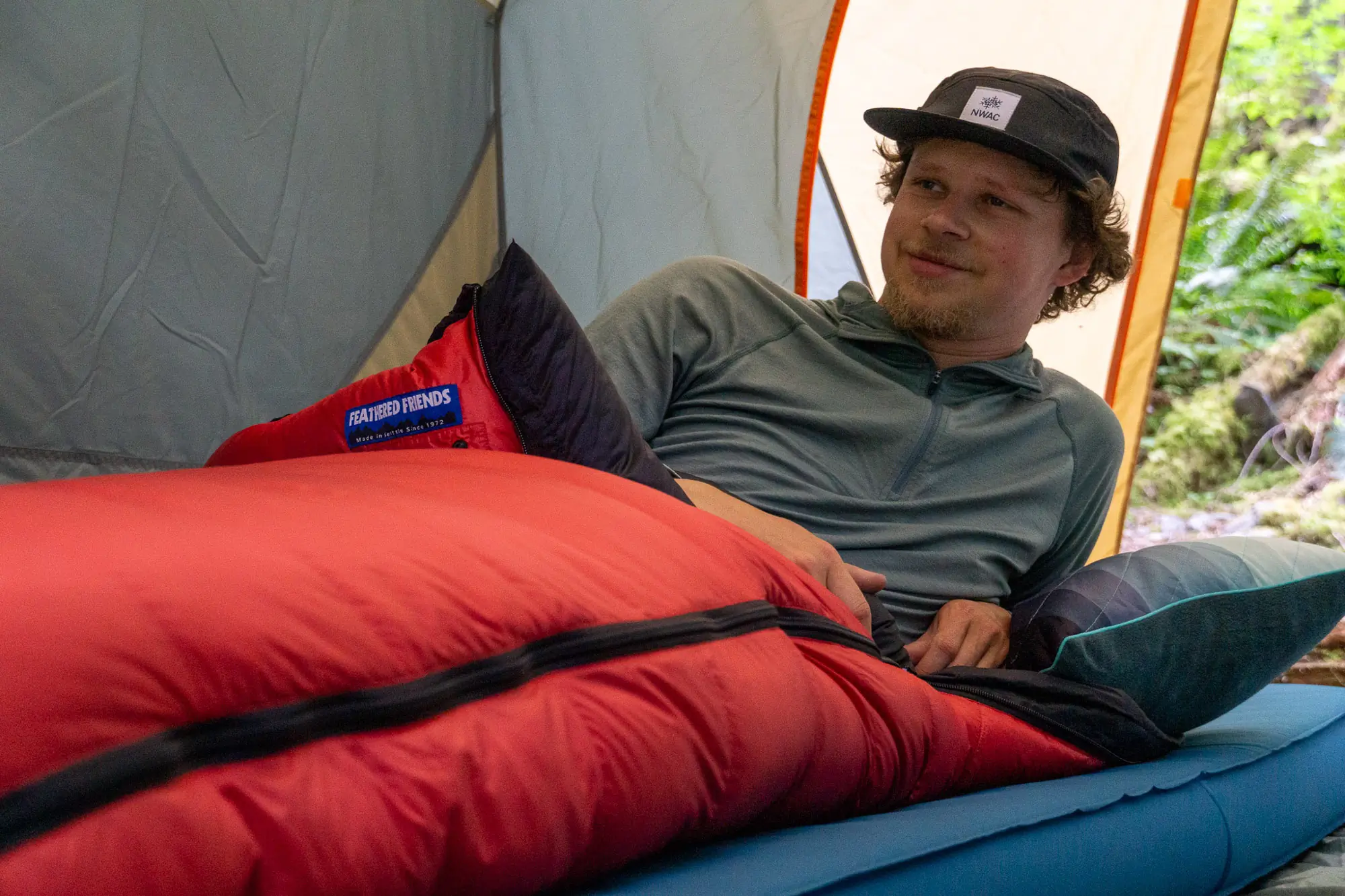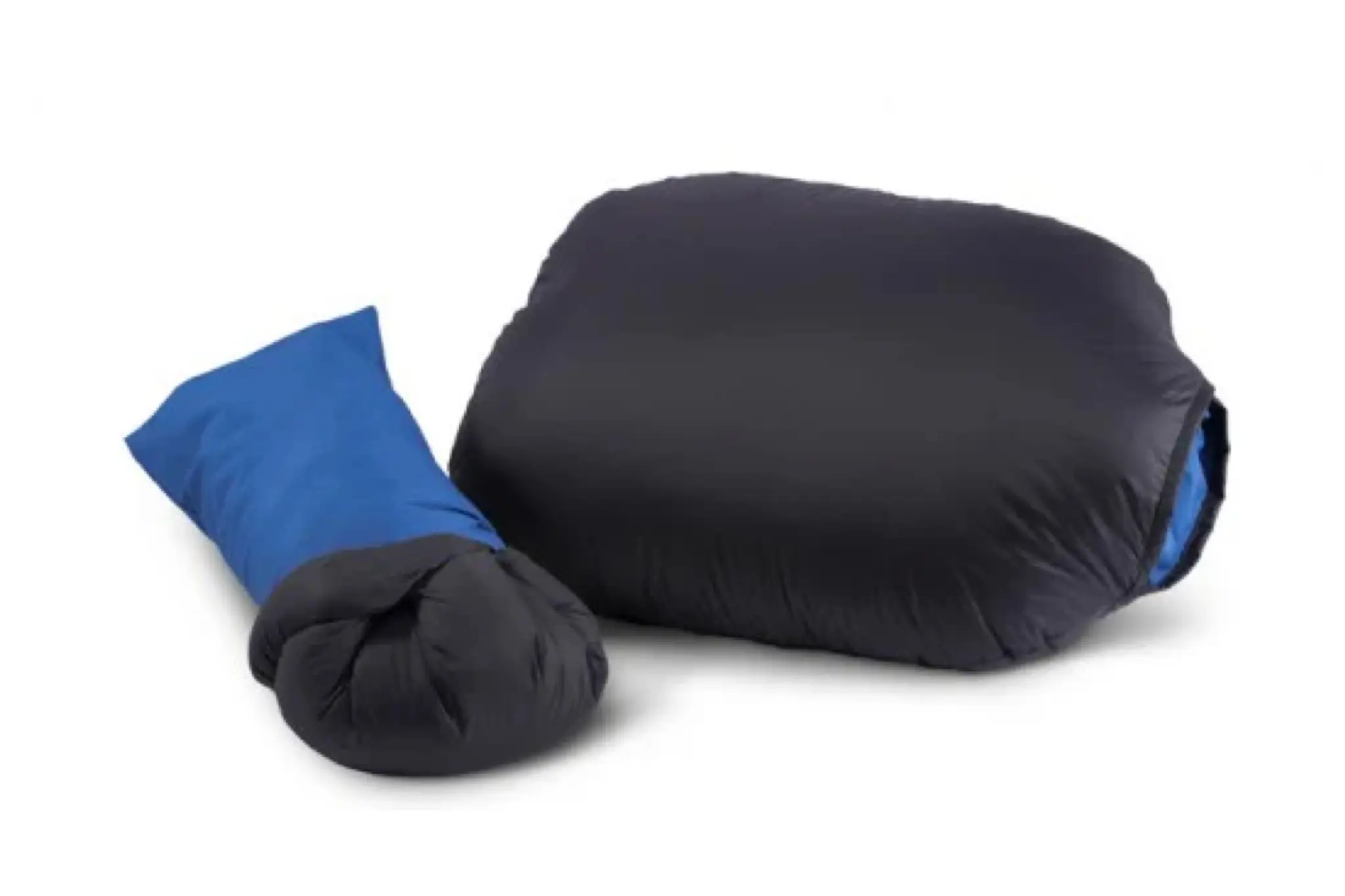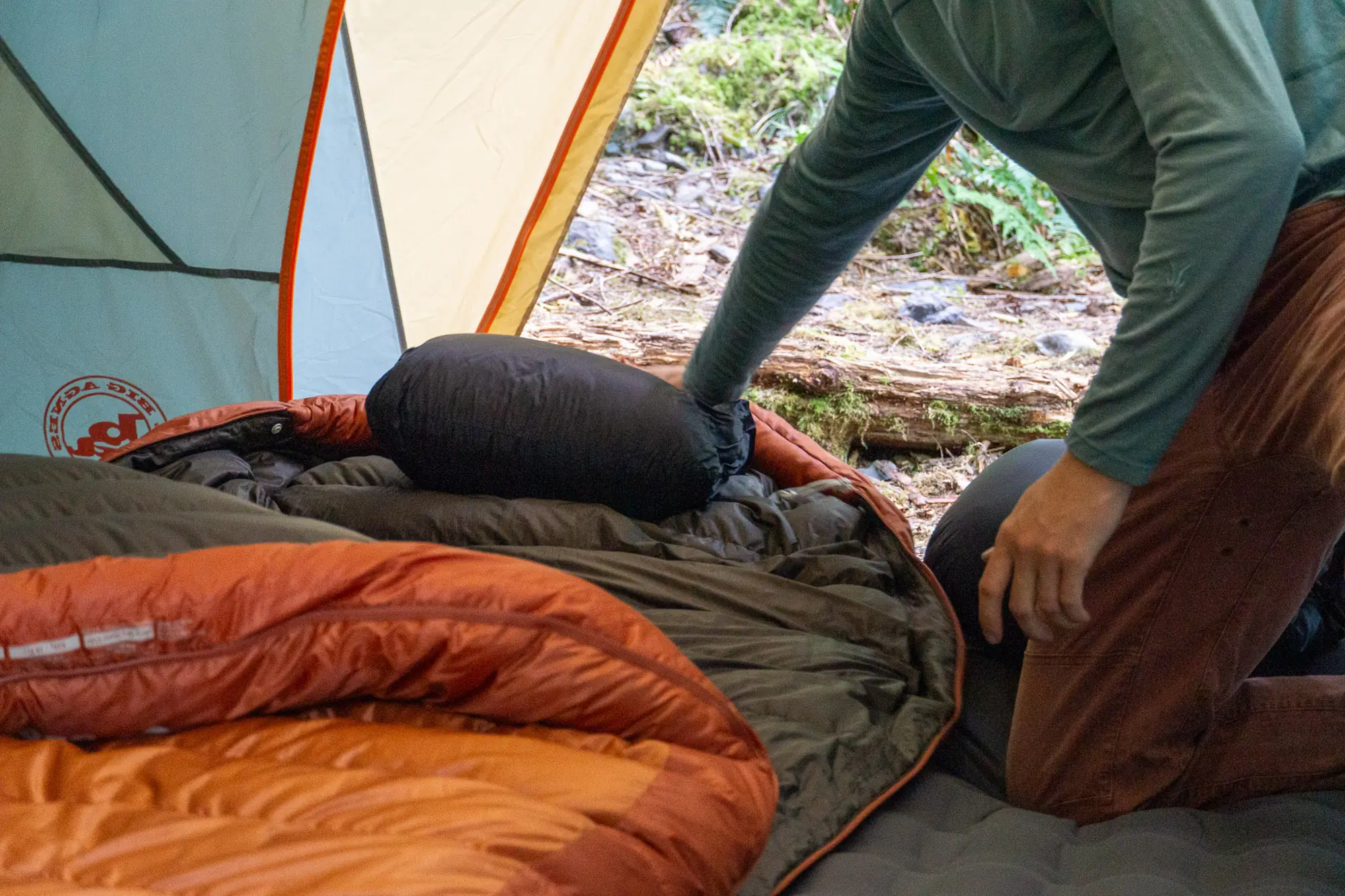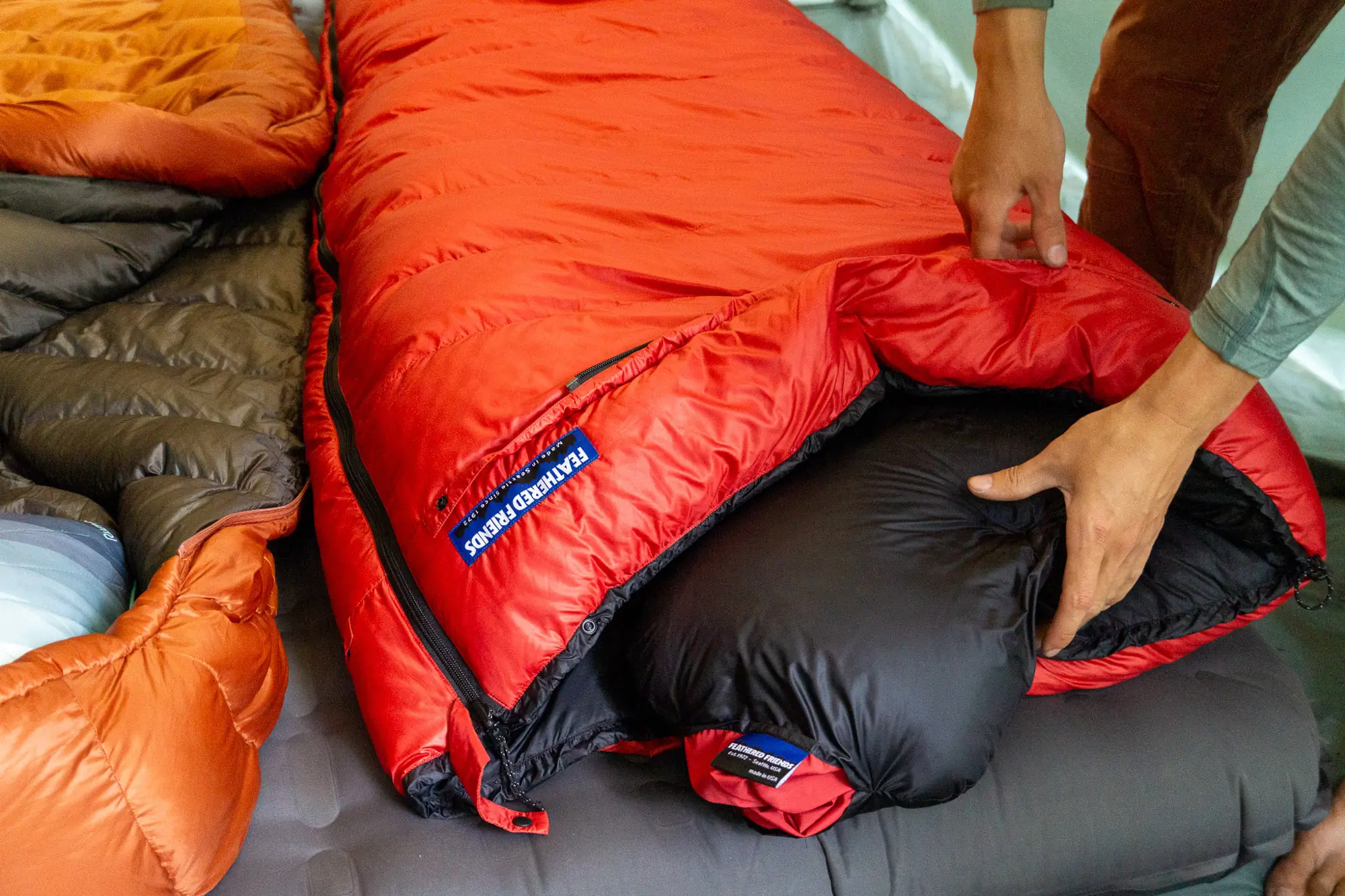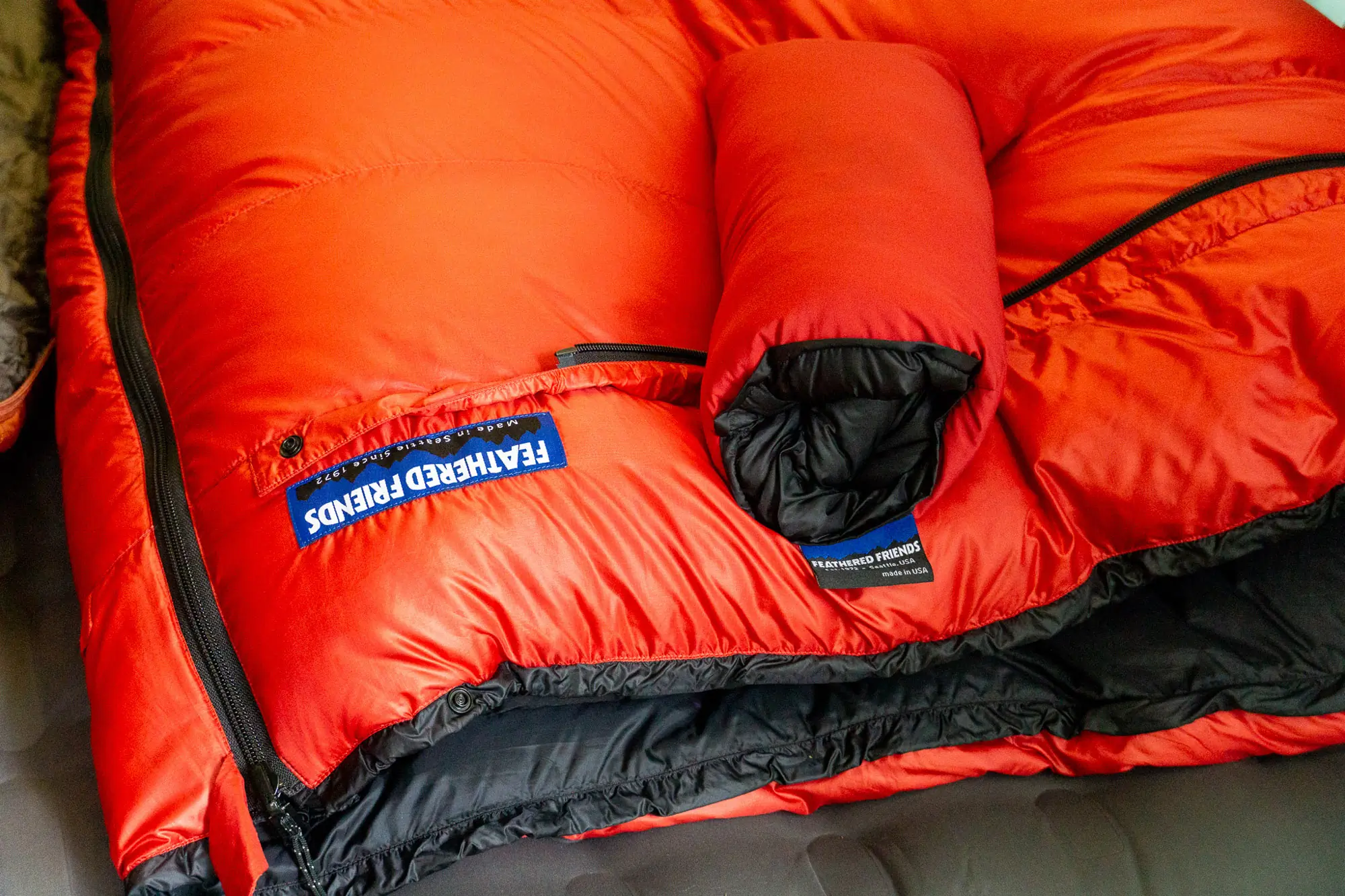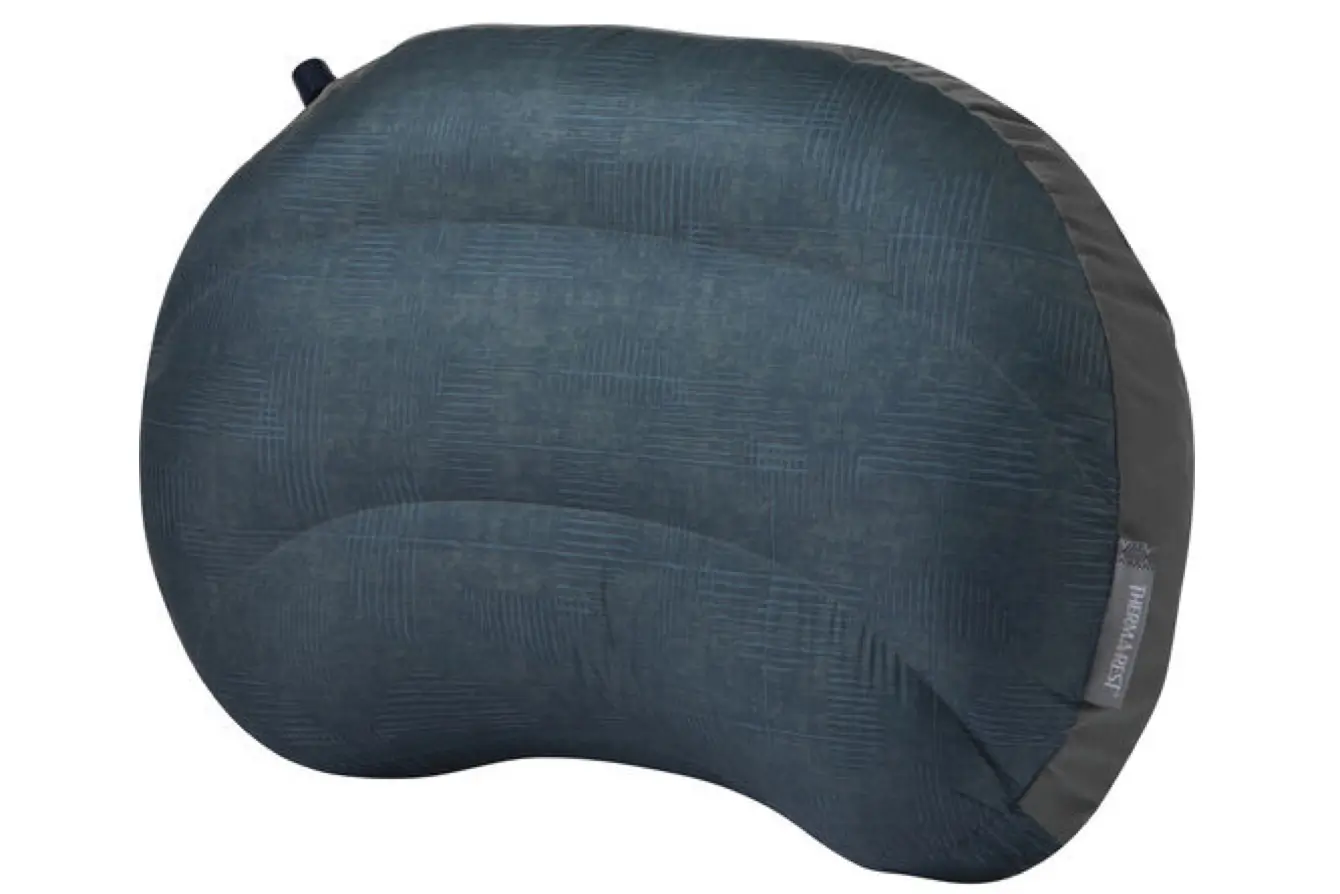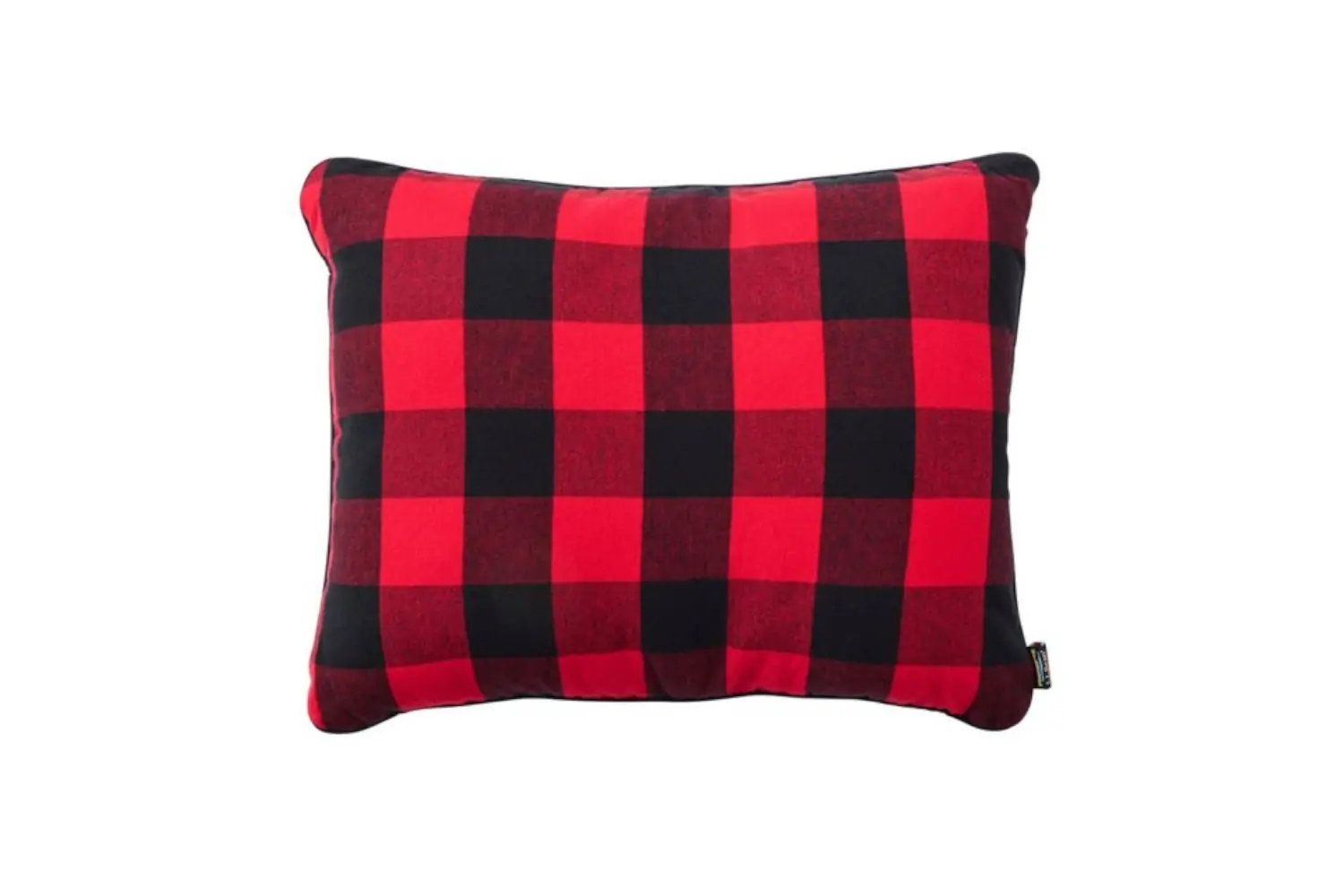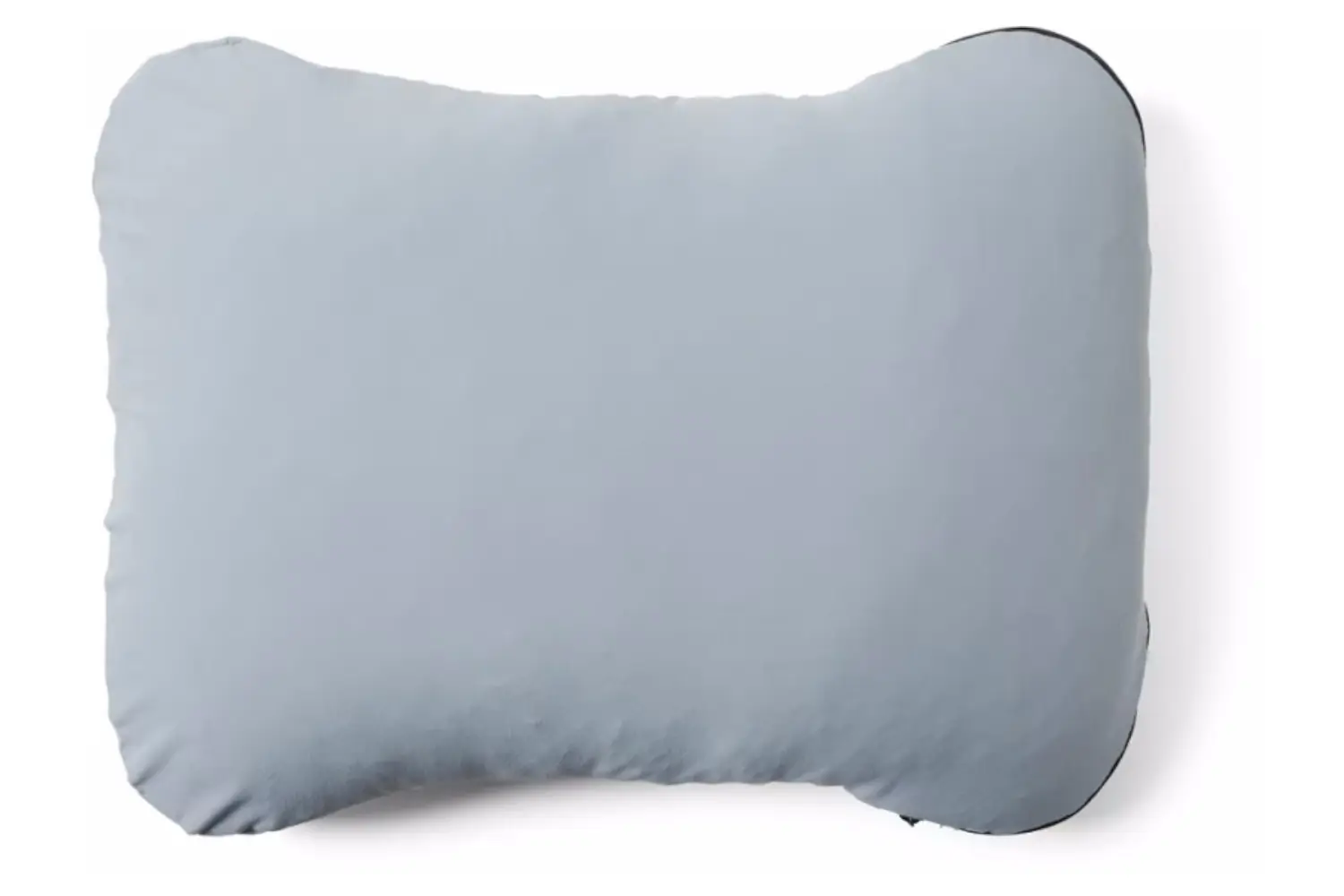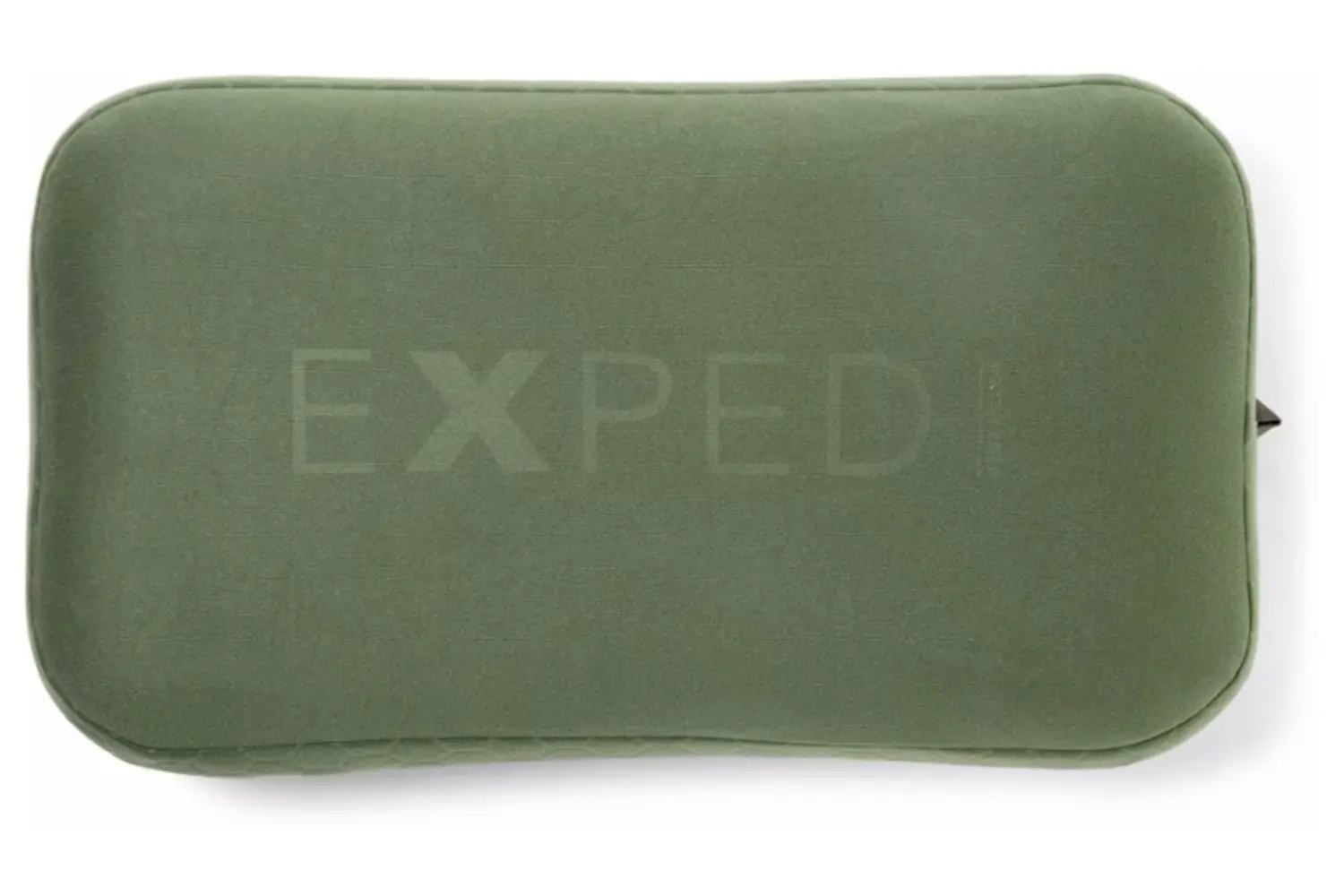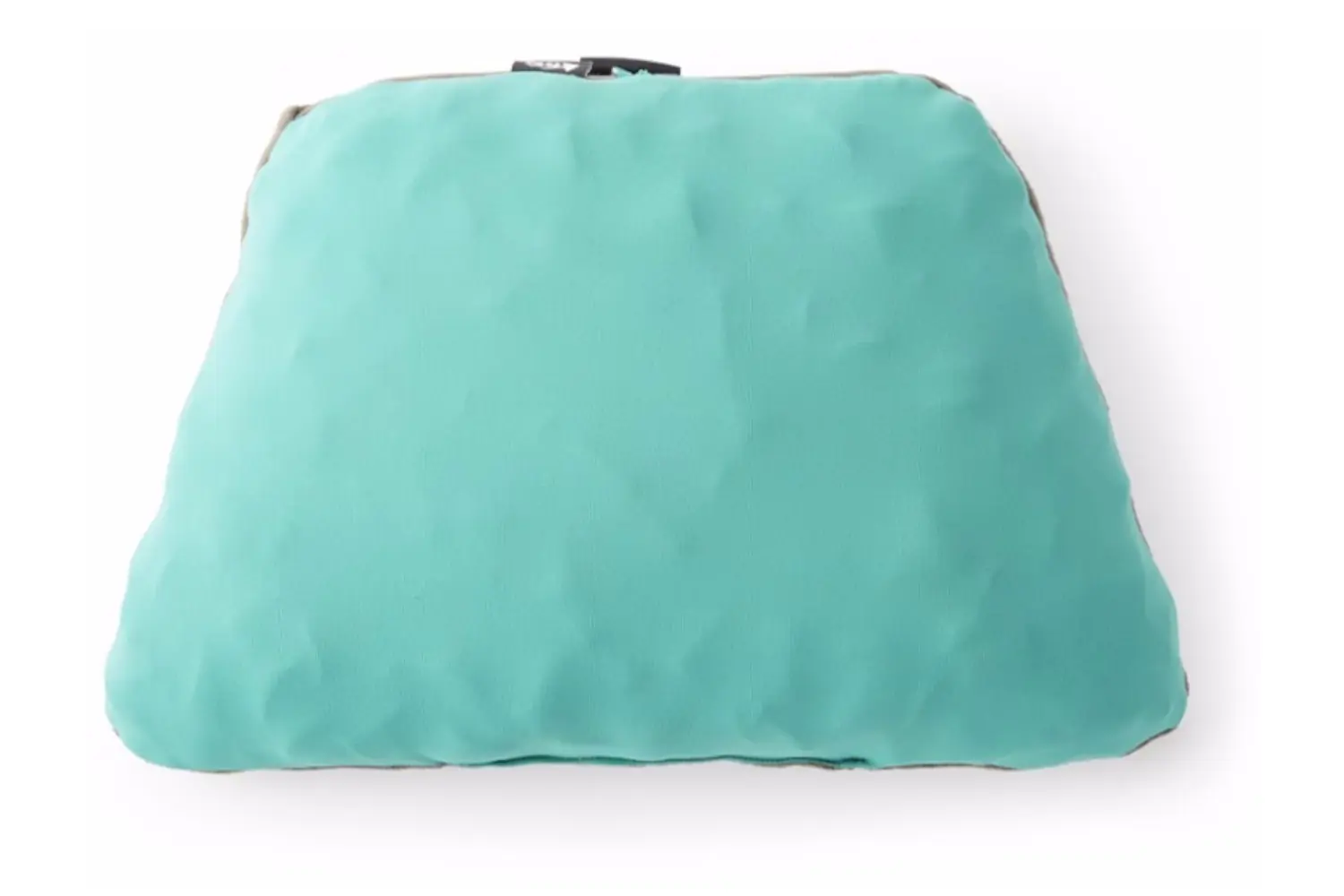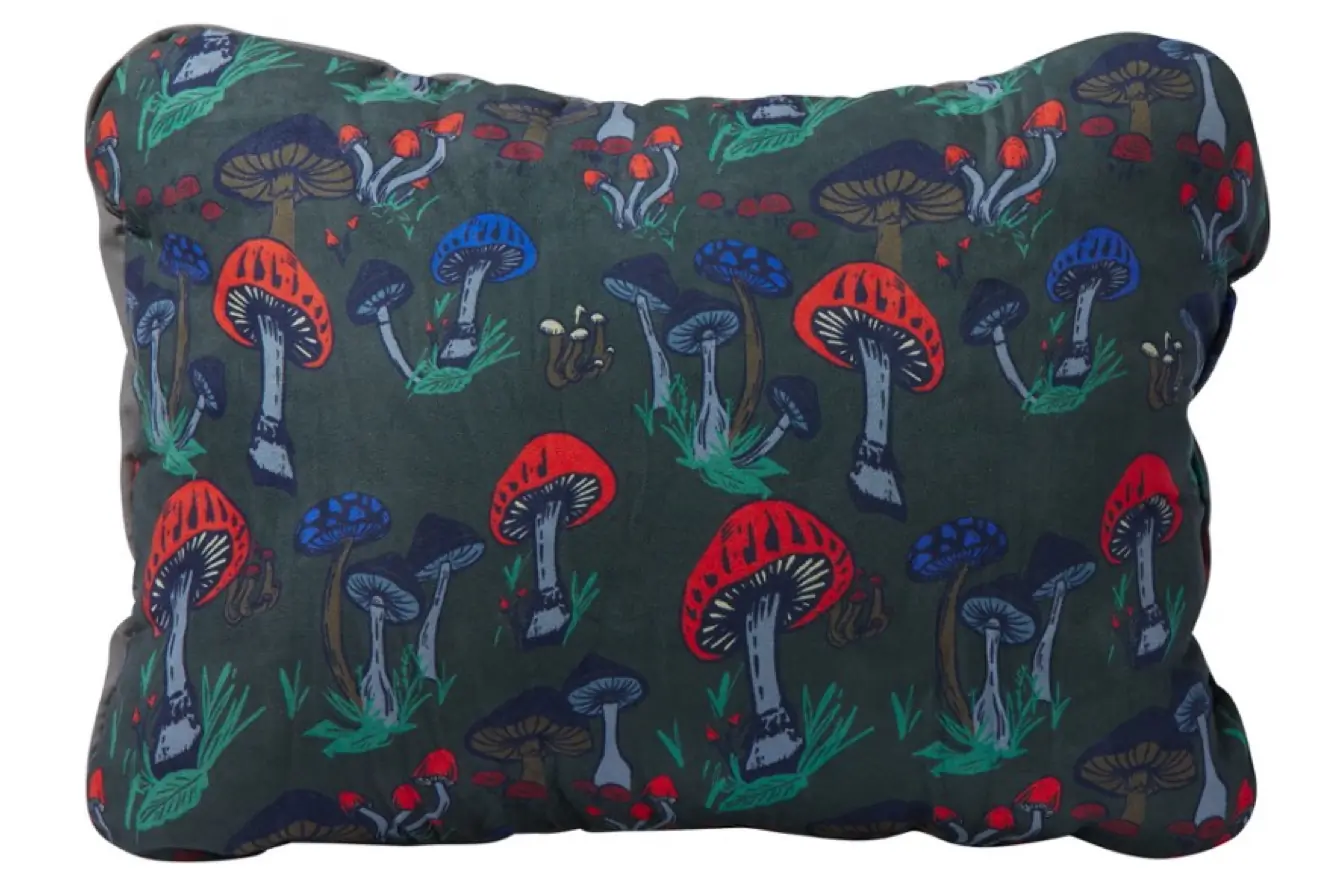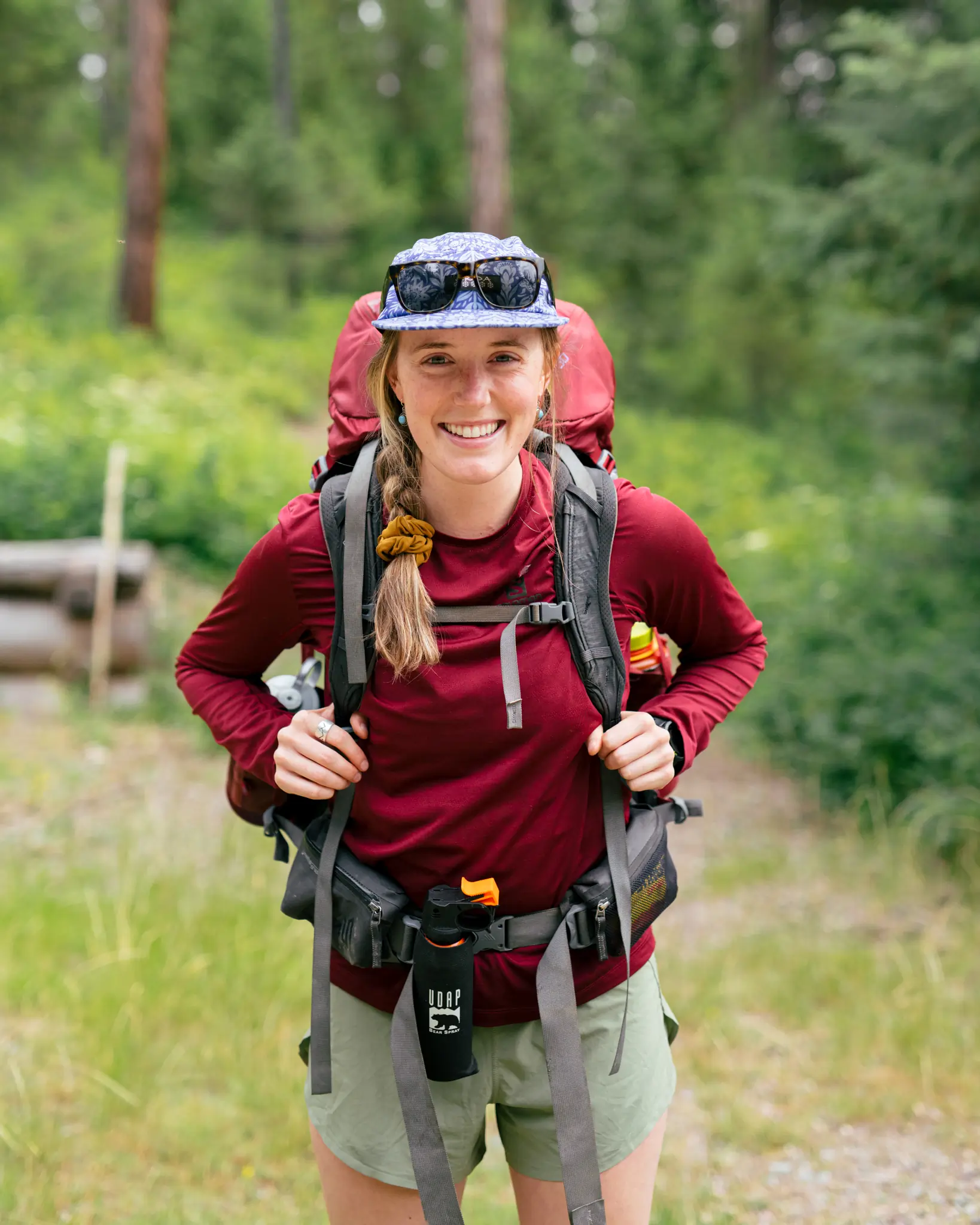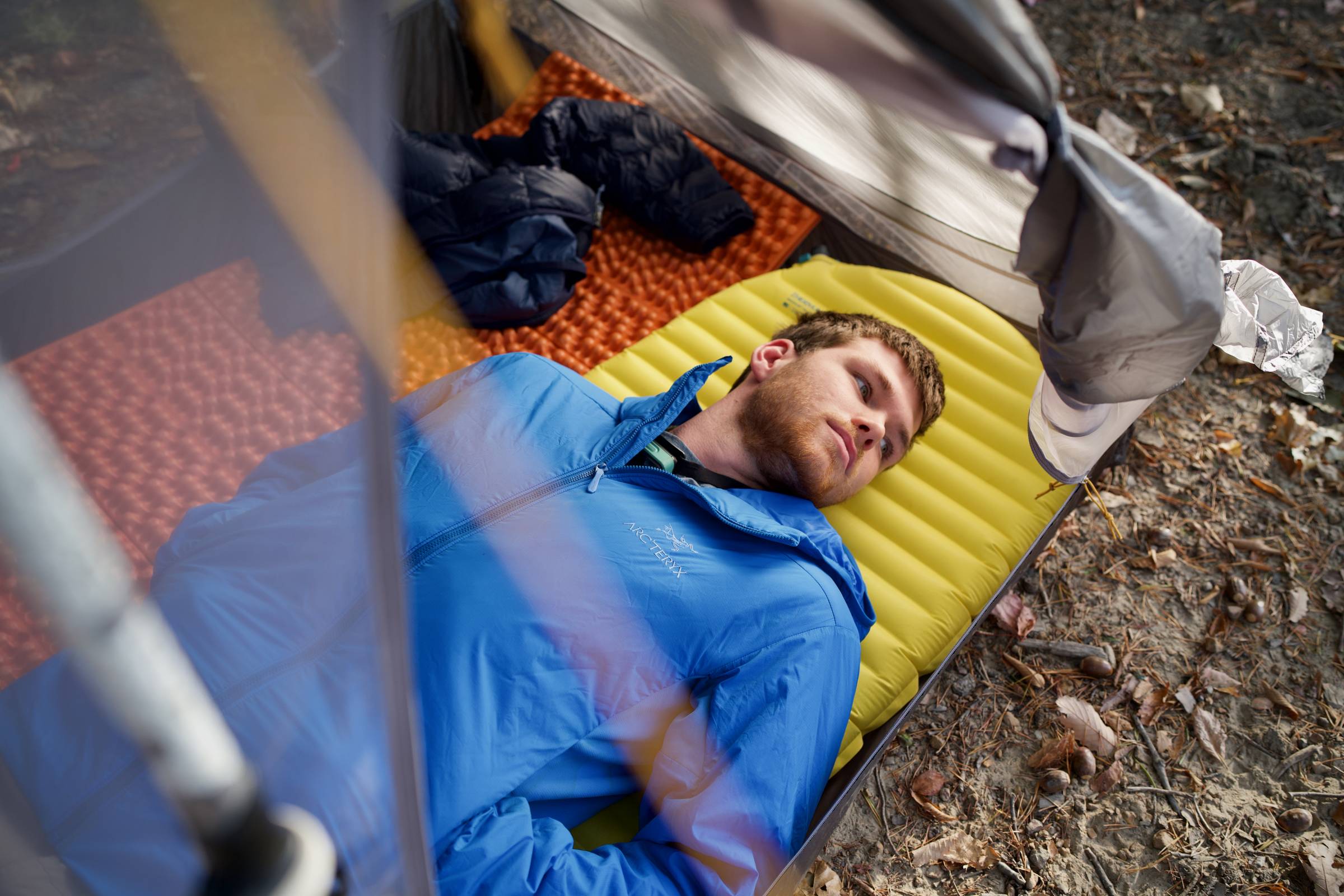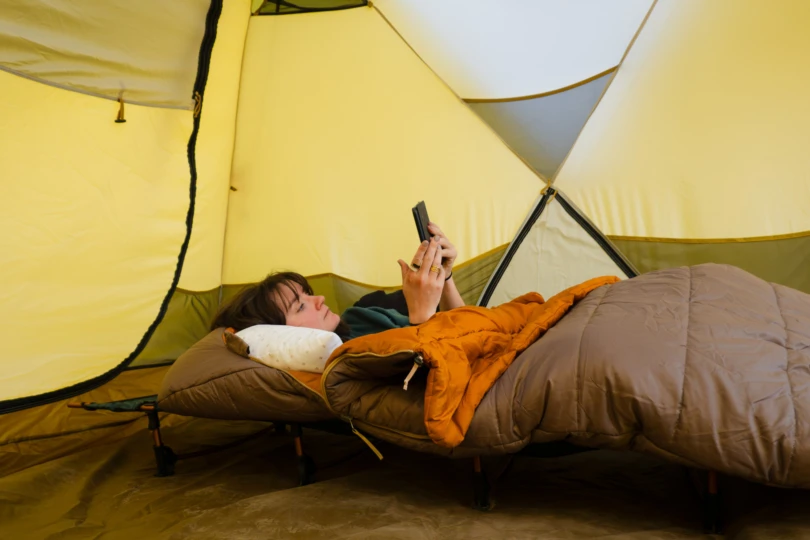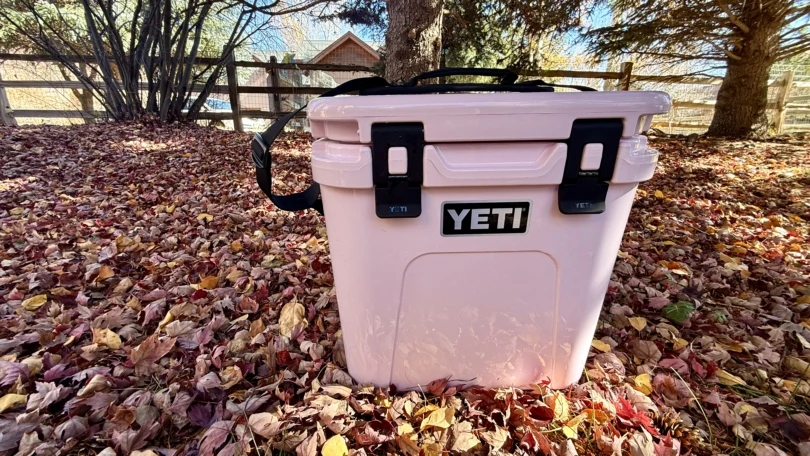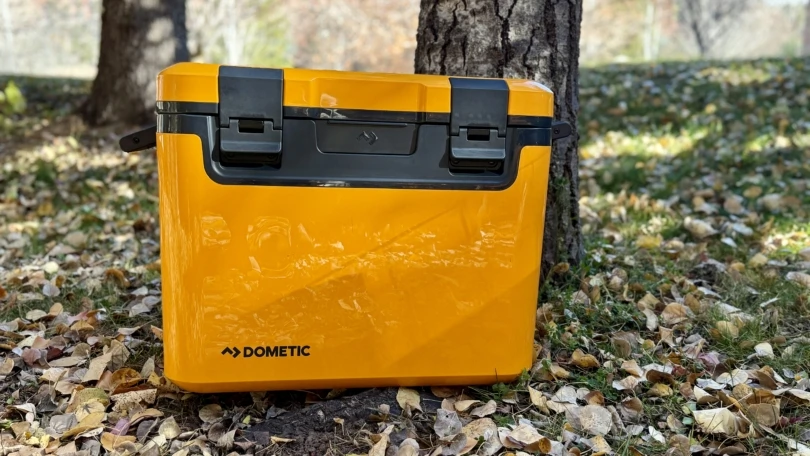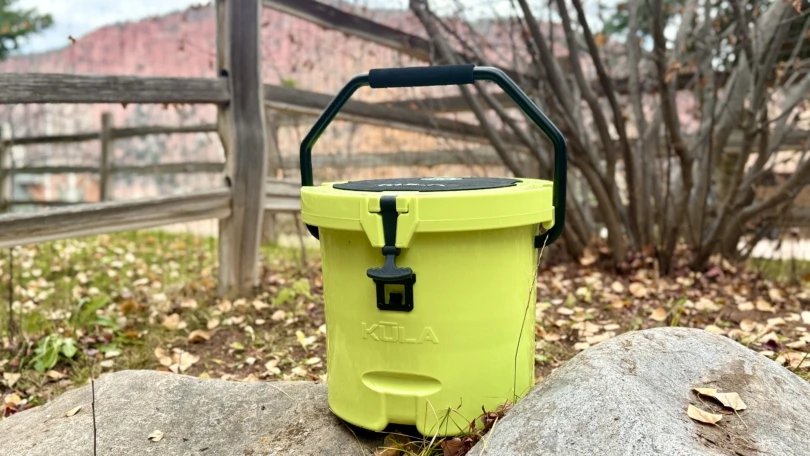Camping doesn’t have to mean roughing it. Gone are the days of wadding up your down jacket and turning it into a makeshift camping pillow while you try to get a few winks. The truth is, sleeping in the great outdoors is just as comfortable as you make it, and we’ve keyed in on the best camping pillows out there to make sure you catch those all-important Zs.
We’ve tested more than two dozen pillows now over close to a decade of wilderness slumber. These pillows have helped us sleep soundly on chilly fall nights and balmy summer ones, at campsites next to babbling brooks, in alpine basins and sometimes just the back of our trucks at a last-minute road trip parking lot. We measured them up against one another on both comfort, but also consider metrics such as price, packability, and ease of cleaning.
Whether you’re after the end-all camping (but not backpacking) comfort of the LUNO Packable Camp Pillow, or maybe need something that can be carried in a pack, like the budget-friendly Cocoon AirCore Hood/Camp Pillow, we’ve pulled together our list of the top cushions for camp snoozes. Check out our recommendations below.
Editor’s Note: We updated our Best Camping Pillows guide on May 9, 2025, to add five new excellent camp pillows, including our new best overall pick, the LUNO Packable Camp Pillow, as well as several other award-worthy camp cushions.
The Best Camping Pillows of 2025
LUNO Packable Camp Pillow
- Type: Foam
- Materials: Polyester jersey and spandex blends outside, shredded memory foam fill
- Weight: 2 lbs., 9 oz.
- Packed Volume: N/A
- Thickness: 6"
- Stuff Sack: N/A
Pros
- Super soft memory foam fill has 6" of cushion
- Adjustable firmness with access zipper
- Warm and cool sides of the pillow
- Washable cover
Cons
- On the pricier side
- Won't pack down very small
Cocoon AirCore Hood/Camp Pillow
- Type: Inflatable
- Materials: Nylon, polyester
- Weight: 4-10.5 oz.
- Packed Size: 4 in x 3 in – 7 in x 5 in
- Thickness: N/A
- Stuff Sack: Separate
Pros
- Tiny packed size
- Choice of two fabrics
- Budget-friendly
Cons
- Slightly finicky valve cap
Rumpl Camp Pillow
- Type: Foam
- Materials: Polarfleece, polyester, recycled memory foam
- Weight: 2 lbs., 1.6 oz.
- Packed Volume: N/A
- Thickness: 7"
- Stuff Sack: Included
Pros
- Extra tall pillow for side sleepers
- Adjustable memory foam fill
- Warmer fleece and cooler polyester sides for temperature regulation
- Nice looking design
Cons
- Tough to get back into its stuff sack
- Too heavy for backpacking
Feathered Friends Geoduck Travel Pillow
- Type: Down
- Materials: Textile outer, 800+ fill-power goose down
- Weight: 6 oz.
- Packed Volume: N/A
- Thickness: 3.5"
- Stuff Sack: Attached
Pros
- Ultra-premium goose down fill
- Quite light
- Fills out the hood of a mummy sleeping bag well
- Relatively affordable for a down-filled pillow
Cons
- Pillow can invert if compressed too quickly
Therm-a-Rest Air Head Down Pillow
- Type: Inflatable and insulated
- Materials: Partially recycled polyester, urethane insert, down fill
- Weight: 4.9 oz. (regular size)
- Packed Volume: 0.6 L
- Thickness: 4 in"
- Stuff Sack: Separate
Pros
- Very comfortable against skin
- Different sizes available
- Sleeping-bag-hood compatible
- Removable and washable cover
- Seasonal versatility
Cons
- More expensive
- A little sticky
- Side sleepers may want more support
L.L.Bean Flannel Camp Pillow
- Type: Foam
- Materials: Cotton flannel, 70-denier nylon exterior, polyester fill
- Weight: 1 lb.
- Packed size: 6 in x 6 in x 10.5 in
- Thickness: N/A
- Stuff sack: Separate
Pros
- Similar to your pillow at home
- Choose between cotton flannel or nylon
- Machine washable
Cons
- Too heavy for anything other than car camping
- Larger packed size
Other Camp Pillows to Catch Some Zs On
- Type: Foam
- Materials: Memory foam, polyester blend
- Weight: 2 lbs., 3.2 oz.
- Packed Volume: N/A
- Thickness: N/A
- Stuff Sack: Integrated
Pros
- Substantial size
- Washable cover
- Customizable loft
Cons
- Noisy zippers
- On the heavier and larger side
- Price
- Type: Foam and inflatable
- Materials: Polyester, open-cell foam
- Weight: 14.1 oz.
- Packed volume: 3.2 L
- Thickness: 6"
- Stuff Sack: Integrated
Pros
- Tons of loft
- Huge expanded size
- Integrated stuff sack
- Machine washable cover
Cons
- Larger packed size than regular-size pillows
- Type: Synthetic fill
- Materials: Polyester shell and hollow fiber fill
- Weight: 1 lb., 11.2 oz.
- Packed Volume: N/A
- Thickness: 7"
- Stuff Sack: Included
Pros
- Dependable summer camp-style pillow
- Deep 7" of cushion
- Two different face fabrics with fleece and cooler polyester
- Affordable pricing
Cons
- Stuff sack isn't the best
- Synthetic fill can hold onto heat
- Type: Inflatable
- Materials: Brushed tricot nylon exterior, 160 g/m Texpedloft microfiber insulation
- Weight: 6 oz.
- Packed Volume: 5.1 in x 3.9 in packed size, inflated dimensions 20.9 x 12.6 x 4.7 in
- Thickness: 4.7"
- Stuff Sack: Separate
Pros
- Large when inflated but packs down small
- Soft tricot nylon material feels good on skin
- Can be attached to a mat
- Removable, washable cover
Cons
- Doesn't fit easily in some sleeping bag hoods
- Can be a little too thick when fully inflated
- Type: Inflatable
- Materials: Polyester with down pillow top
- Weight: 2.5-6.7 oz.
- Packed Size: 3 x 2.5 in-3.5 x 2.7 in depending on size
- Thickness: 4.7"
- Stuff Sack: Separate
Pros
- Very lightweight
- Won't slip off pad
- Down pillow top for extra comfort
- Inflate with a few breaths
Cons
- Not machine washable
- Hot sleepers might not need or like the down topper
- A little noisy
- Type: Stuff sack
- Materials: Dyneema Composite Fabric, microfleece
- Weight: 1 oz.
- Packed Volume: Unavailable
- Thickness: Depends what you stuff in it
- Stuff Sack: Integrated
Pros
- Lightest pillow available
- Doubles as a stuff sack
- Optional pillow attachment cord keeps pillow where you need it
Cons
- Only as comfortable as what you pack inside it
- Limits use as stuff sack (avoid wet or sweaty clothes, food)
- Type: Foam
- Materials: Recycled polyester
- Weight: 5.25 oz.
- Packed Size: 15.1 x 9.6 in
- Thickness: 5"
- Stuff Sack: Attached
Pros
- Price
- Compresses fairly small
- Ideal fit for a mummy bag
- Recycled materials
Cons
- Lumpy
- Takes a while to fluff up
- Not the smallest packed size
- Type: Foam
- Materials: Polyester, urethane foam scraps
- Weight: 7-15 oz.
- Packed Volume: 2.6 L
- Thickness: 5-7", depending on size
- Stuff Sack: Integrated
Pros
- Incredibly soft
- Mimics the feel of a full-size pillow
- Fun patterns
Cons
- Takes time for the foam to fully expand
- Some users find it lumpy
- Not as lightweight as some competitors
Camping Pillow Comparison Chart
| Camping Pillow | Price | Type | Materials | Weight | Packed Volume |
|---|---|---|---|---|---|
| LUNO Packable Camp Pillow | $60 | Foam | Polyester jersey and spandex blends outside, shredded memory foam fill | 2 lbs., 9 oz. | N/A |
| Cocoon AirCore Hood/Camp Pillow | $30 | Inflatable | Nylon, polyester | 4-10.5 oz. | 4 in x 3 in – 7 in x 5 in |
| Sea to Summit Aeros Premium Pillow | $55 | Inflatable | 50D brushed polyester stretch knit face, synthetic fill | 2.7 oz. | 0.4 L |
| Rumpl Camp Pillow | $49 | Foam | Polarfleece, polyester, recycled memory foam | 2 lbs., 1.6 oz. | N/A |
| Feathered Friends Geoduck | $45 | Down | Textile outer, 800+ fill-power goose down | 6 oz. | N/A |
| Therm-a-Rest Air Head Down Pillow | $63-73 | Inflatable and insulated | Partially recycled polyester, urethane insert, down fill | 4.9 oz. (regular size) | 0.6 L |
| L.L.Bean Flannel Camp Pillow | $30 | Foam | Cotton flannel, 70-denier nylon exterior, polyester fill | 1 lb. | 6 in x 6 in x 10.5 in |
| HEST Camp Pillow | $89 | Foam | Memory foam, polyester blend | 2 lbs., 3.2 oz. | N/A |
| NEMO Fillo King | $75 | Foam and inflatable | Polyester, open-cell foam | 14.1 oz. | 3.2 L |
| Teton Sports Camp Pillow | $36 | Synthetic fill | Polyester shell and hollow fiber fill | 1 lb., 11.2 oz. | N/A |
| EXPED Mega Pillow | $60 | Inflatable | Brushed tricot nylon exterior, 160 g/m Texpedloft microfiber insulation | 6 oz. | 5.1 in x 3.9 in packed size, inflated dimensions 20.9 x 12.6 x 4.7 in |
| Sea to Summit Aeros Down Pillow | $65-90 | Inflatable | Polyester with down pillow top | 2.5-6.7 oz. | 3 x 2.5 in-3.5 x 2.7 in depending on size |
| Zpacks Medium Pillow | $55 | Stuff sack | Dyneema Composite Fabric, microfleece | 1 oz. | Unavailable |
| REI Co-Op Trailmade Mummy Bag Pillow | $25 | Foam | Recycled polyester | 5.2 oz. | 15.1 x 9.6 in |
| Therm-a-Rest Compressible Pillow | $32-47 | Foam | Polyester, urethane foam scraps | 7-15 oz. | 2.6 L |
How We Tested the Best Camping Pillows
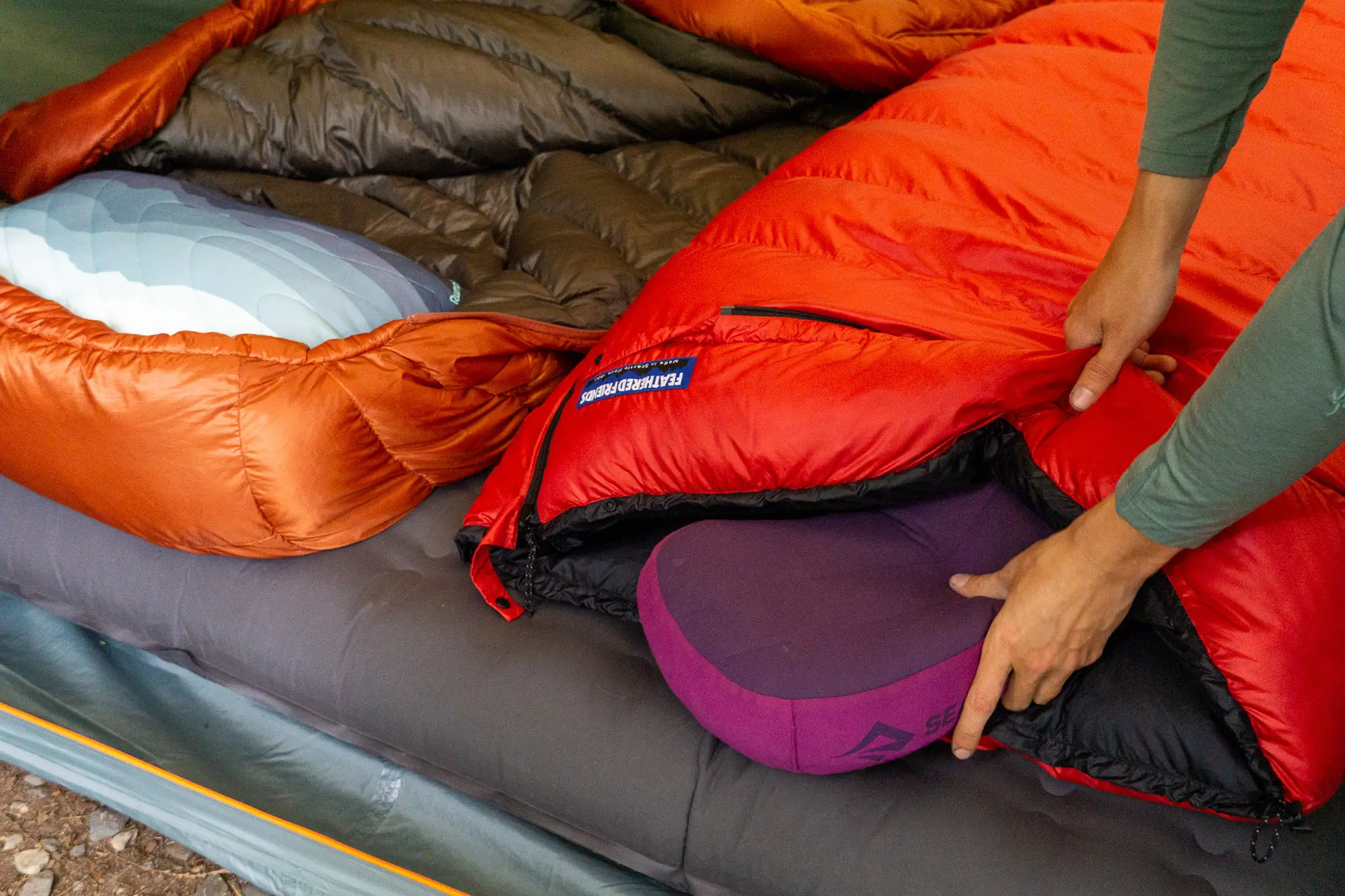
Our Testing Process and Testing Grounds
The GearJunkie staff knows our way around a campsite, and we’ve brought together our collective experience here to find the best of the best camping pillows available today. In our search, we aimed to find and test pillows that every outdoors person across the spectrum could enjoy — from luxury-minded car campers to ounce-counting ultralight backpackers.
When we bedded down for testing, we paid close attention to a number of different factors, including overall comfort, durability, and packed size and weight (someone’s got to carry these pillows, after all). The better the sleep, the more likely we are to actually bring the pillow, and not resort to balling up layers and waking up with an aching neck.
Our testing also got a little techy, and we broke out the scales and measuring tape to get real-deal numbers on weights, packed sizes, and the all-important cushion height. In order to quantify relative compression we used a 2-pound kettlebell to measure the amount of sag each pillow, and we also noted how well these pillows laundered, how easy they were to adjust support on, and how much space they took up in our different sleeping bags.
Then we hit the trail with these pillows. Each were distributed to a member of our testing team and slept on for a number of nights, with pillows being cycled out to get a broad impression between different sleepers. After it all, we compile our testing notes and render our verdict.
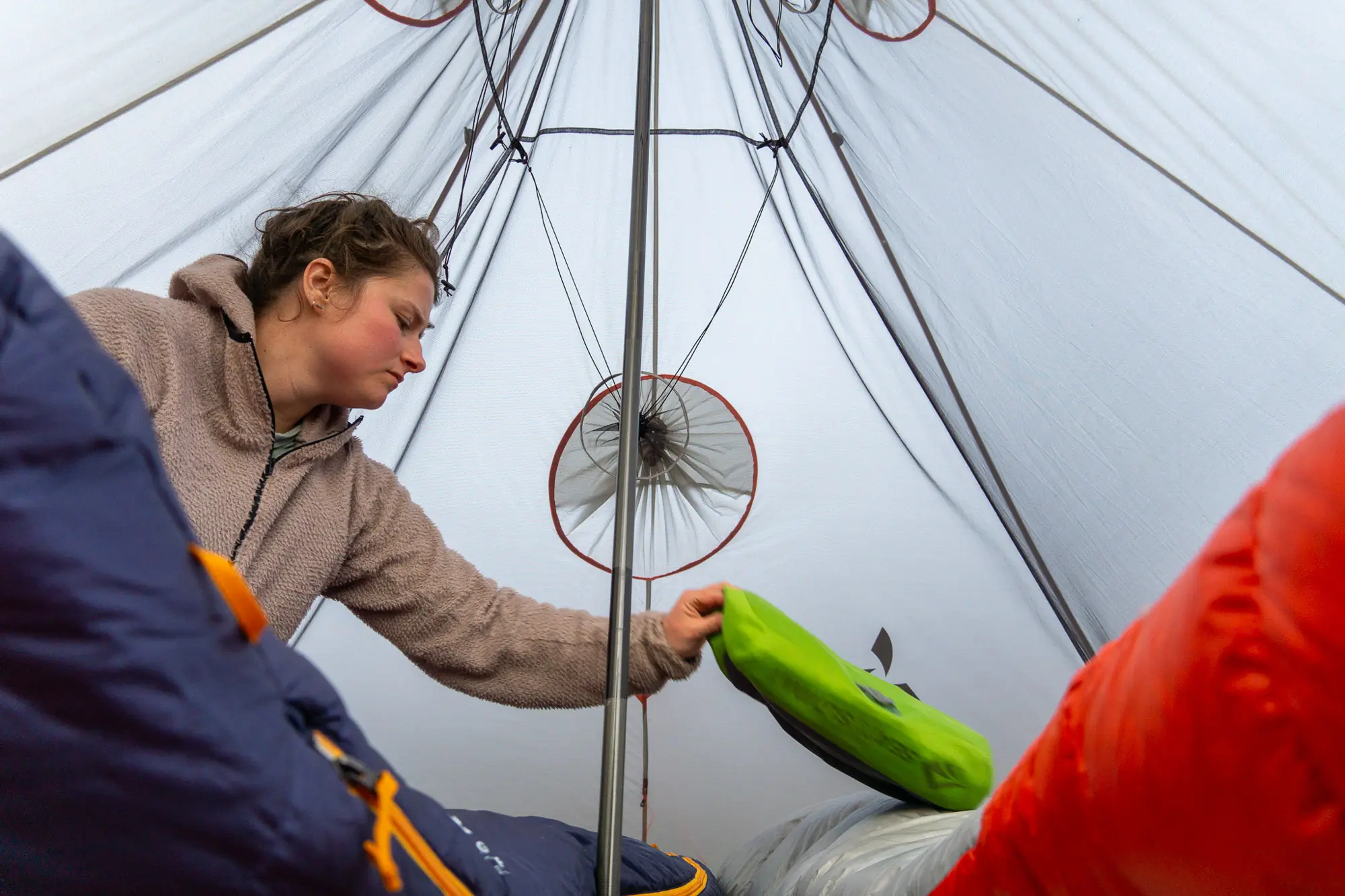



Our Expert Testers
Lead tester Kylie Mohr has been camping since she was a homesick little kid at YMCA camp in northwestern Washington; today, she likes to explore the Montana wilderness at her fingertips, as well as neighboring Idaho and Wyoming, on a variety of camping trips.
Car camping by a creek to later fish, or backpacking to an alpine basin to revel in wildflowers with friends, Mohr put these pillows to the test this spring on over five camping trips with multiple testing partners. She tested every pillow herself on at least one overnight in a tent, and another overnight in her bed at home, to really get a feel for every option in a variety of environments. She also packed them along on afternoon hammock hangs and reading sessions in parks to really bolster her comfort and log more testing hours.
We at GearJunkie have been testing camping pillows for a number of years, and while outdoor equipment won’t last forever, we’ve had good results in getting many seasons of use out of the options we’ve tried out so far.
Finally, the testing doesn’t stop here, and as new camping pillows hit the market we’ll be chucking them in our packs and continue testing, ensuring that our lineup is as fresh as can be.
Buyer’s Guide: How to Choose a Camping Pillow
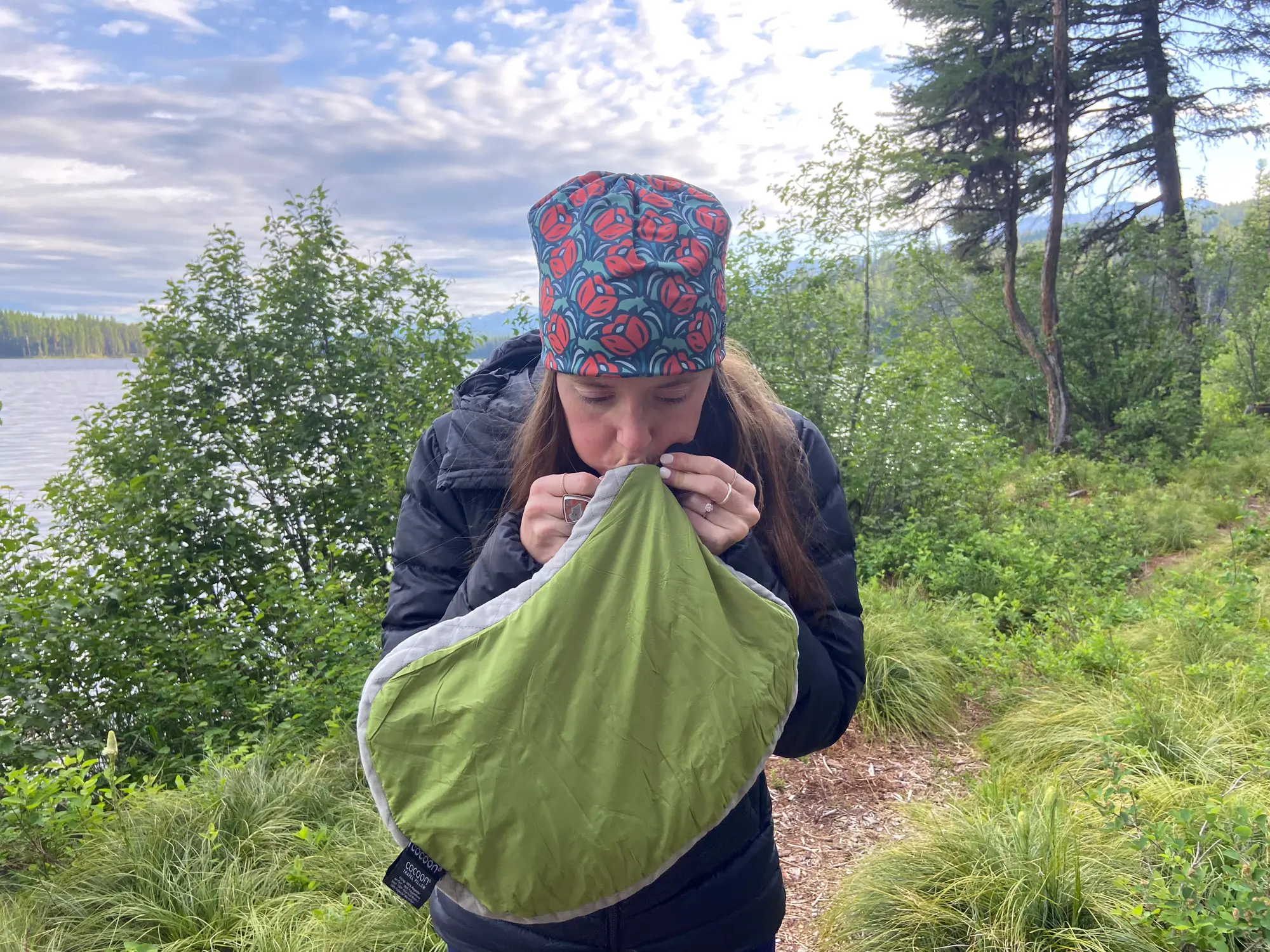



Camping Style
Car Camping
Choosing the right pillow depends largely on how you usually camp. Specifically, do you sleep in your car, or do you hike out into the woods before you tuck in for the night?
Car campers can go the more luxurious route. Because you don’t have to carry the pillow around with you or fit it into a backpack, packed size and weight don’t matter.
Often, people will just bring along their everyday pillow to sleep on. But campfire smoke and the dirt and dust that come with living outdoors for a few weeks can leave your pillow smelly and dirty, rendering it unfit for use back home.
Car camping pillows are made of durable and easily cleaned materials, so you can beat them up at a campsite without worrying about whether they’ll be usable when you get back home.
When choosing a car camping pillow, comfort is king. Go for a bigger pillow and one that uses foam filling. Foam pillows like the Therm-a-Rest compressible pillow and the REI Co-op Trailmade Mummy Bag Pillow use foam cutaways from the brand’s sleeping pad construction. When unpacked, the foam puffs up and feels like a traditional feather pillow for a great night’s sleep.
Backpacking
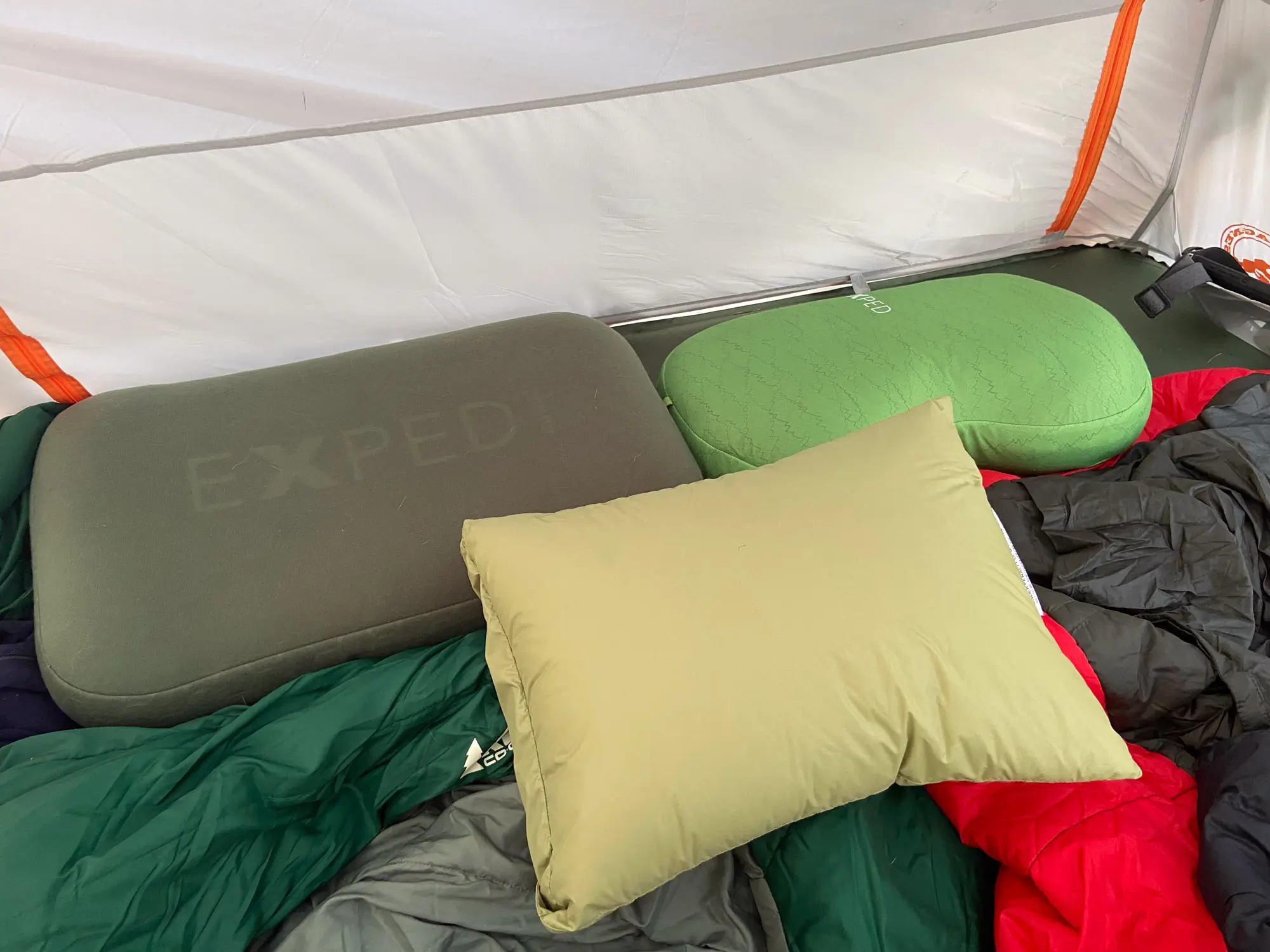



Backpackers have a lot more to consider than car campers, as they’ll be carrying their pillows with them in the wild. Pack space and weight are issues here, as you’ll be working with limited space in your pack and feeling every ounce with every step.
Inflatable pillows are a good option for backpackers because they pack down small and don’t weigh as much. The downside to inflatable pillows is that they provide little insulation from the ground, and they can make a crunching sound when you move on them (to go along with your inflatable sleeping pad). They also tend to be firmer than foam pillows.
We’ve found that a pillow that combines foam cushioning and an air core, like NEMO’s Fillo, is a great compromise between the two. Upcycled foam from the brand’s production process is used on the head side, and the core is inflatable for extra loft.
Side sleepers love the Fillo King’s extra loft. The lightest one we’ve found is a converted stuff sack from Zpacks. Backpackers have often used stuff sacks filled with clothes as makeshift pillows, and Zpacks took this a step further by lining the inside with a soft fleece material for added comfort. Our lightest pillow that isn’t just a stuff sack is the Sea to Summit Aeros Ultralight Pillow, which, at its smallest size, is a mere 2.5 ounces.
Comfort
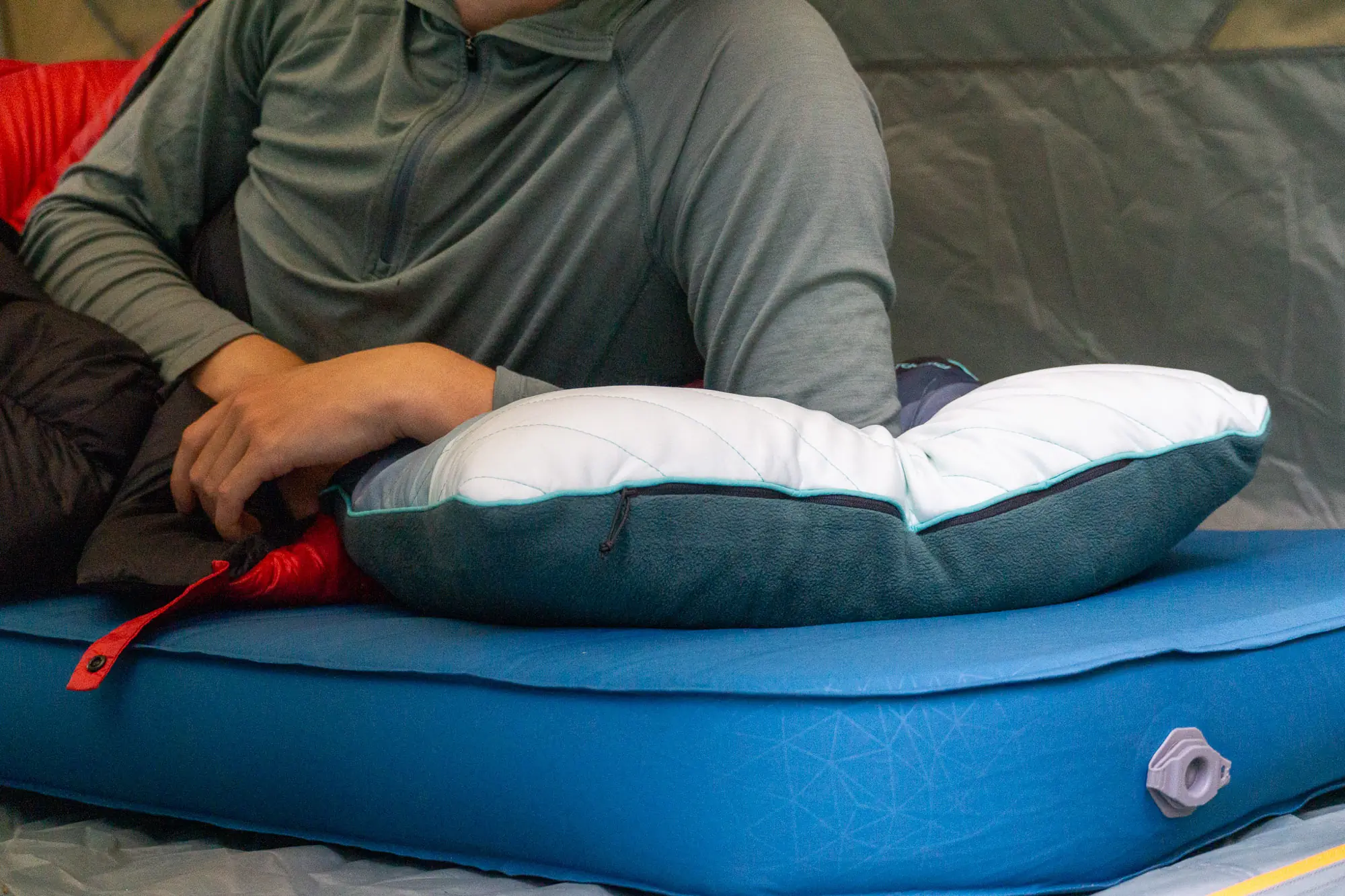



It doesn’t matter how light a camping pillow is if it isn’t comfortable. Often, there is going to be a trade-off between comfort and lightness, but pillow companies are going to great lengths to minimize that compromise.
Some companies like Sea to Summit and Trekology have added contouring to their pillows, basically creating an inflatable hammock for the head. This lowers the chance of the pillow sliding around from underneath you.
It also helps to keep your head on the pillow if you tend to move around in your sleep. Other pillows feature straps or sticky material to prevent them from sliding around on your sleeping pad. Sometimes these locks are proprietary, meaning they only work with the brand’s own pads (like the Sea to Summit Aeros Ultralight Pillow or Aeros Down Pillow) — something to keep in mind.
The style of the pillow is also worth considering. Foam-filled pillows (like the vintage-feeling L.L.Bean Flannel Camp Pillow) are softer and replicate feather pillows better than inflatable ones, but the additional weight and space requirements can be an issue.
We’re fans of pillows that combine the two, whether the cushioning is actual foam or a lightweight synthetic fill. If you’re looking for the true feather pillow experience, look no further than the Feathered Friends Geoduck Travel Pillow, which is filled with 4.6 ounces of 800+ fill power goose down.
Cocoon’s Sleeping Bag Hood Pillow has a thin layer of synthetic fill over the air bladder for a soft feel at the head. One thing to note is that, when fully inflated, air pillows can feel too firm for some campers. Make sure to use the valve to fine-tune the softness of your pillow.
Face feel is another consideration, particularly for side and stomach sleepers. Most pillows feature a brushed polyester side for a softer touch. Many of our favorite pillows, including the LUNO Packable Camp Pillow, have a choice between nylon and some sort of microfiber on the other side. Don’t forget to consider the stuff sack. You might prefer it to be attached or sewn onto the pillow itself if you tend to lose things or want to keep your gear more contained.
Packed Size
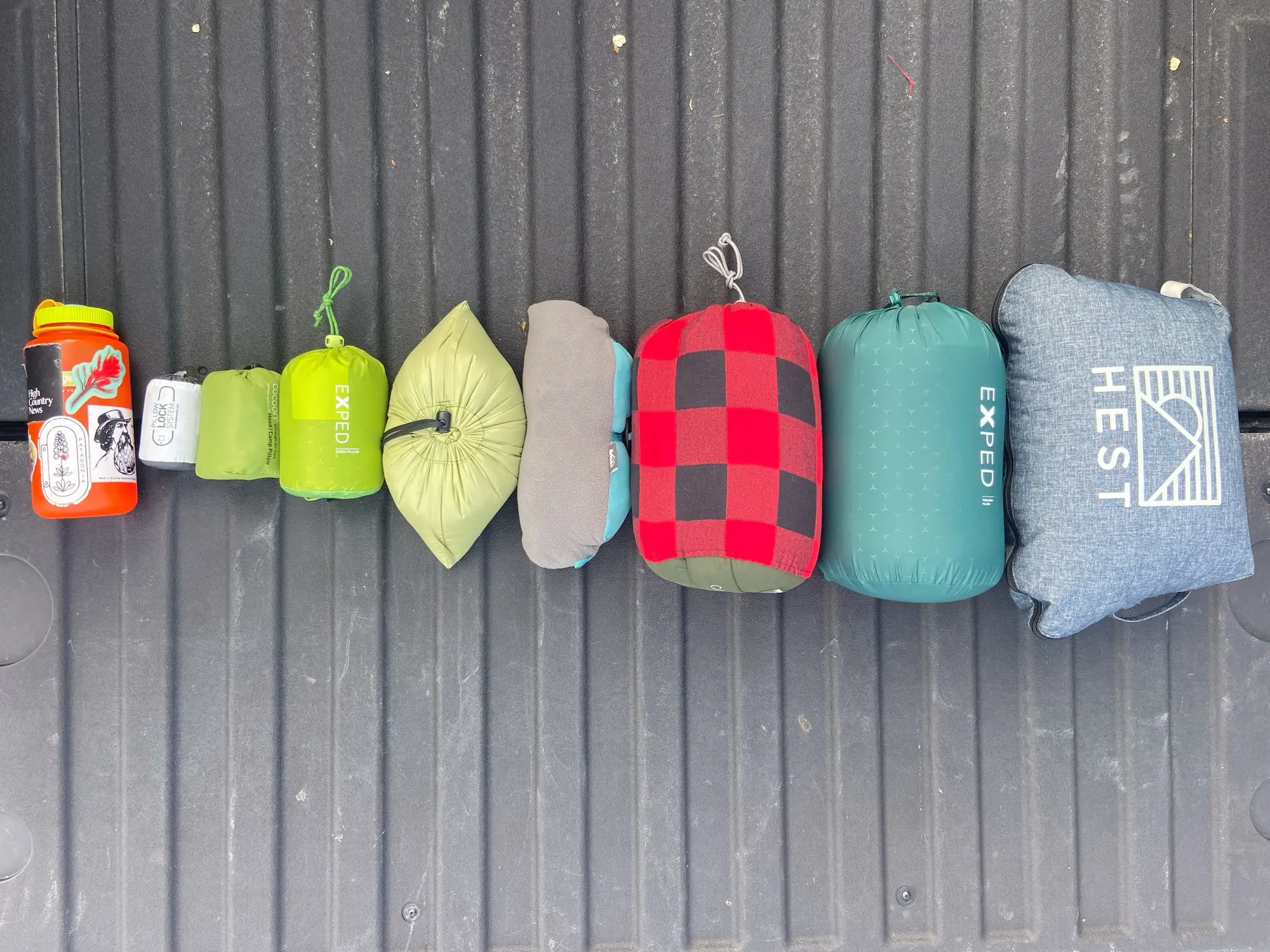



If you’re car camping, packed size isn’t an issue, as you can stuff your pillow anywhere. For backpackers, how small your pillow packs down is a huge consideration.
Your backpack has limited space. Trying to fit everything you need into it can take a huge amount of creativity (and some serious Tetris skills). A tiny inflatable pillow can leave you more room for extra food, more layers, battery packs, or anything else you can think of bringing.
While often less comfortable than foam pillows, inflatable pillows tend to pack down to the smallest size. We’ve seen some that pack down to the size of an orange, which will leave plenty of room in your pack.
If you’ve got the room for it and you want a more comfortable option, a foam pillow usually packs down to the size of a Nalgene bottle. Smaller pillows can also fit into an exterior pocket or an extra water bottle pocket. This saves space in the pack’s main compartment.
If you’re really hurting for space, you can usually strap a pillow and any extra gear to the outside of your pack. The main issue with this is that it leaves the pillow at risk of snagging on a branch or rock. This can puncture a pillow’s air bladder and render it useless, so keeping it in the pack or a pocket is the preferred option.
Weight
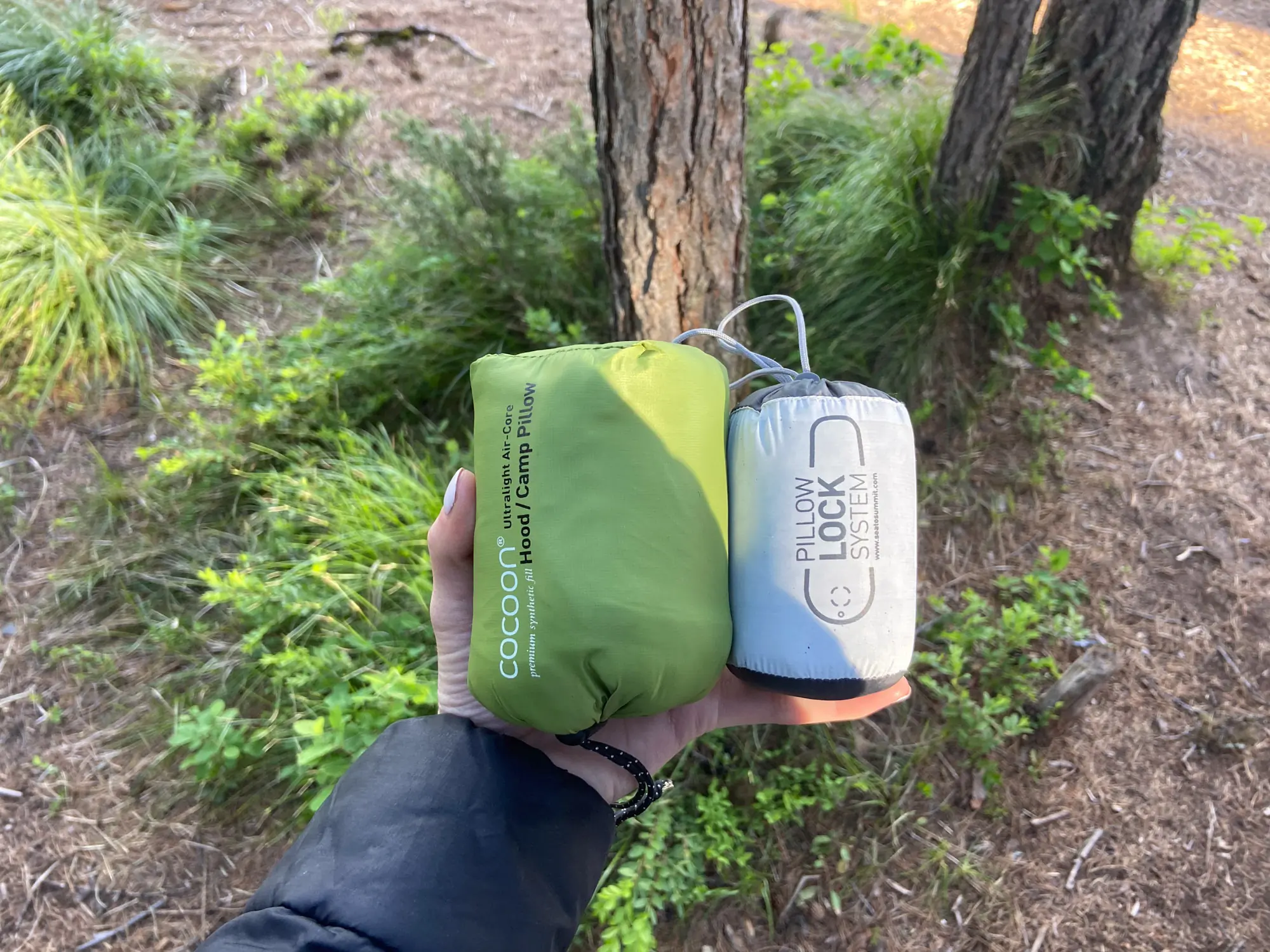



Again, car campers don’t need to worry about weight. But backpackers need to count every ounce; every bit of weight added to the pack wears on their shoulders, backs, and knees.
When it comes to pillows, there has always been a trade-off between weight and comfort. Softer, fluffier foam pillows feel great when you go to bed, but the added weight can drag you down.
Inflatable pillows tend to feel firmer and are generally noisier than foam but can weigh half as much as foam pillows. When you’re looking for a lightweight backpacking pillow, look for one that weighs well under a pound.
Some of the best pillows we’ve seen have weighed 10 ounces or less without sacrificing much comfort, including the EXPED Mega Pillow and Cocoon AirCore Hood/Camp Pillow. If you really want to save weight, the Medium Pillow from Zpacks is a great choice. It’s essentially a stuff sack with a soft interior.
If you turn it inside out and stuff it with clothes, it makes a great pillow. And at just an ounce, you’re not going to find a lighter option. Also, you’re using gear that you’d be bringing with you anyway, so you don’t have to save space for a pillow.
Durability
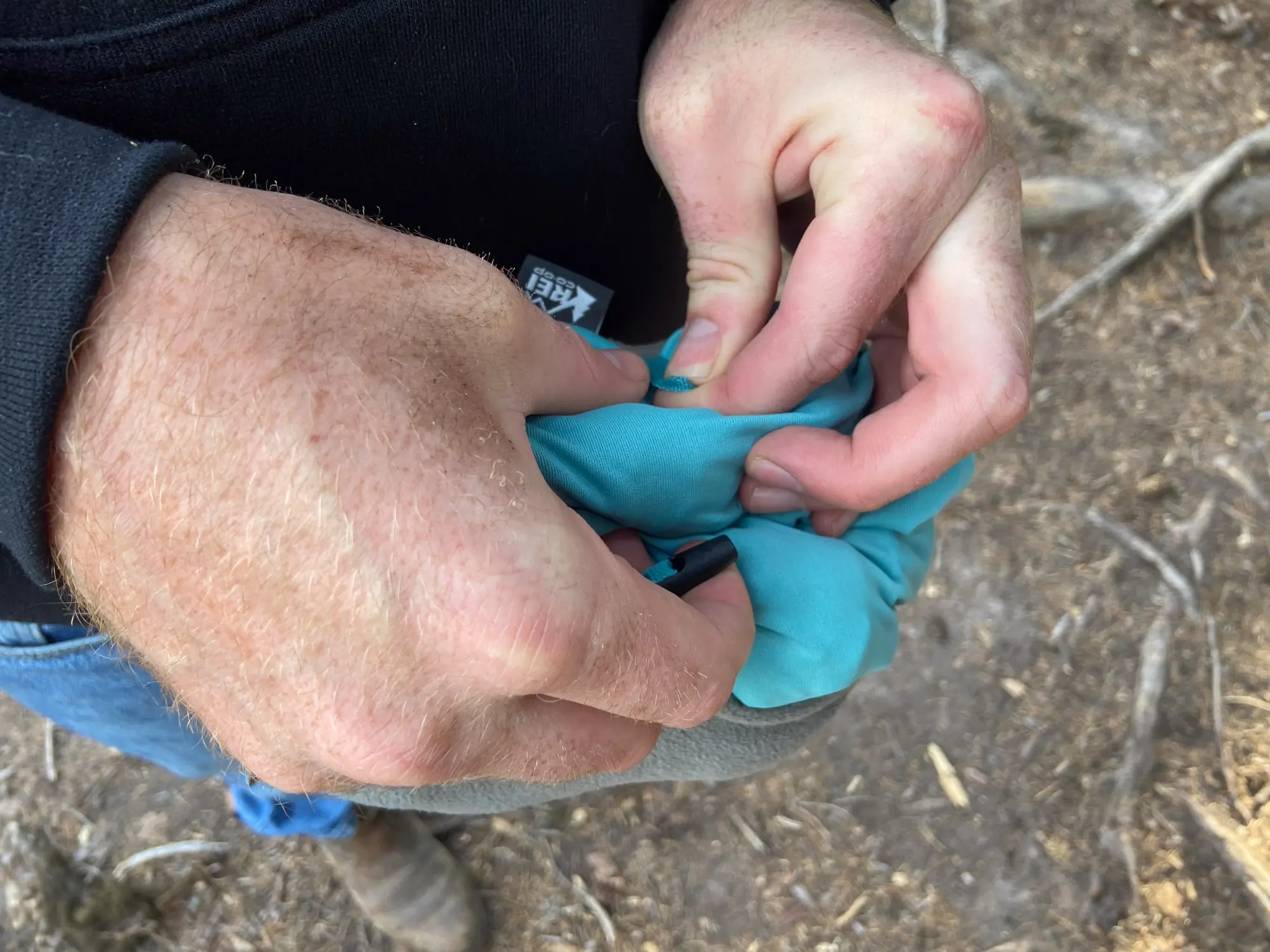



Generally, camping pillows are used inside the tent, so a decent pillow should last a while. With foam pillows, durability isn’t a huge issue, as they’ll work well even with a few small holes in the fabric. But it’s a huge issue with inflatable pillows; even a tiny pinprick could flatten it by the end of the night.
Even if you only use your pillow inside the tent, debris like pine needles and twigs can get into the tent. These little bits can eventually find their way to your pillow and find a way to puncture it in the middle of the night.
Look for inflatable pillows that are made up of durable material, like thermoplastic polyurethane (TPU), or one that comes with a more rugged cover, like the HEST Camp Pillow. Valves can also be a weak point on an inflatable pillow. Make sure the one you buy has a tough, well-built valve that isn’t prone to leaking. And ask around — fellow campers and online reviews are your best resources for gauging a pillow’s durability over time.
With a little care, you can prolong the life of your camping pillow. Always store it in your stuff sack to add a protective layer, and don’t carry it on the outside of your pack. Passing branches can poke or tear holes in your pillow while you hike, so be sure to store it somewhere inside the pack, whether it’s the main compartment or in an exterior pocket.
We like to flatten our pillows out and roll them up in our sleeping bags. This serves not only to add an extra layer of protection but also to keep our sleeping gear together so we don’t have to search for the pillow when setting up camp.
Price & Value
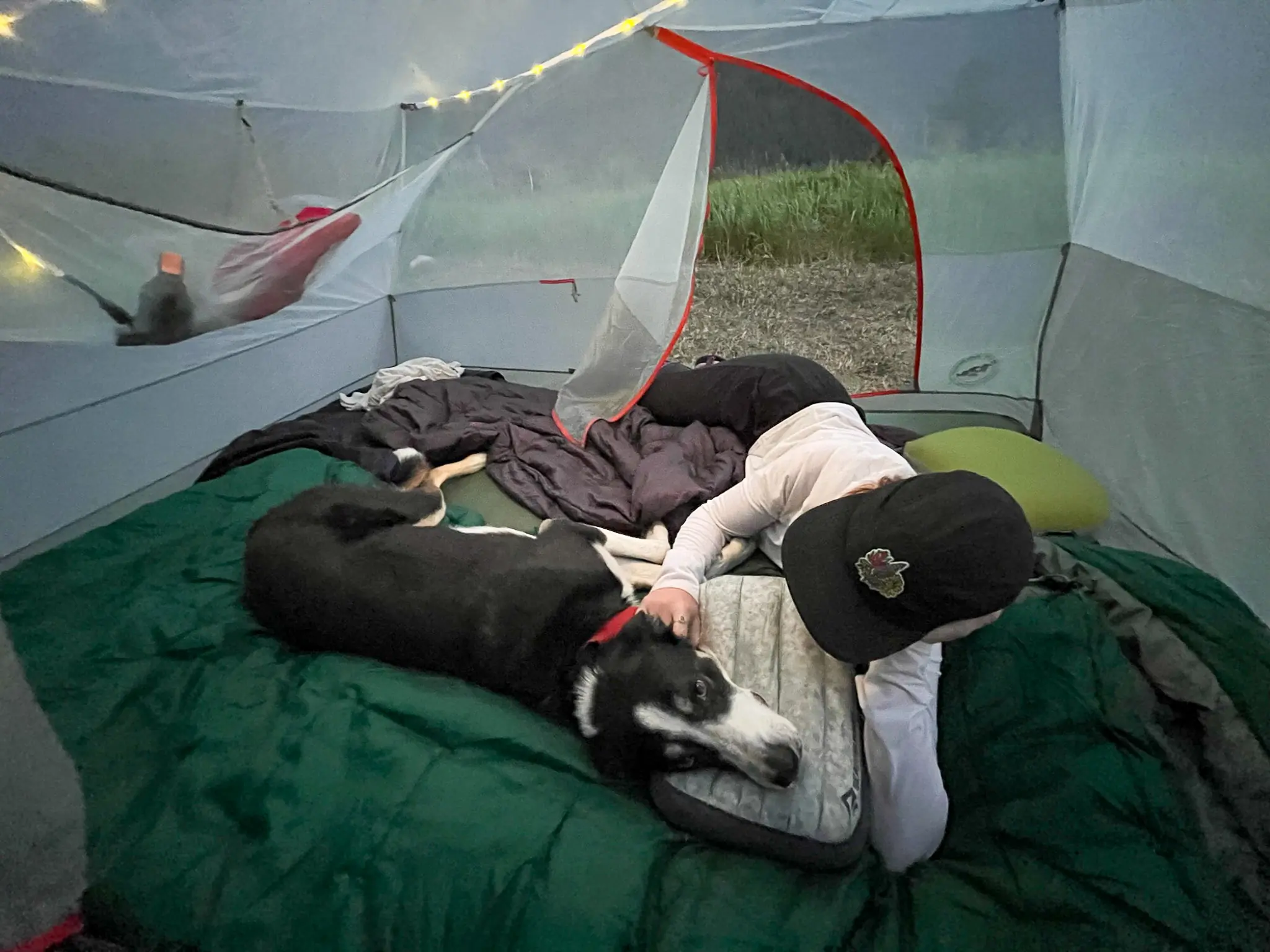



In general, the more features a pillow has, the higher the price will be. Lighter, more compressible pillows tend to cost more than their heavier, bulkier counterparts. On the plus side, well-established companies like NEMO and Sea to Summit have spent more time developing their products, dialing down more durable and comfortable designs.
When you shop for a pillow, determine your must-have features, weigh them against your budget, and find a camping pillow that’s best for you. If you’re new to camping and still trying to figure out what kind of pillow you want, go for a good budget pillow. It’s a great way to test a pillow without making too big of an investment.
Budget
If you’ve got 2,600 more miles ahead of you, you’re likely looking to save some coin, and choosing even a budget camp pillow is better than wading up your socks under your head. More often a simpler air bladder design, budget pillows don’t offer up much in terms of modulating the comfort level, but will get the job done. Expect to pay between $20 and $35 for pillows like the Cocoon Aircore Hood/Camp Pillow and Trekology ALUFT 2.0.
Mid-Tier
Primed for backpacking and camping, even mid-tier camping pillows can afford to pile on the luxury, with microfleece covers, added synthetic insulation, and be offered in multiple sizes. For between $40 and $75, you can tuck into pillows like the EXPED Mega Pillow ($60) that have a bunch of support, squishy and soft like the Therm-a-Rest Compressible Pillow ($37), or even primed for thru-hiking like the Medium Pillow from Zpacks ($55).
Premium
The inclusion of down insulation is typically the difference between middle-of-the-pack camping pillows and premium options — but not always. The HEST Camp Pillow ($89) asks for near a hundo for the real-deal memory foam pillow feel it provides. For a hybrid design that does pack on the feathers, the deluxe-sized Sea to Summit Aeros Down Pillow ($90) is our go-to.
Camping Tips & Tricks: Get a Good Night’s Sleep
Tent Location


We’ve spent enough evenings slowly sliding off our sleeping pads or waking up crammed into a corner of our tents to know the value of finding level ground, so pick your tent spot wisely. When you find your campsite, drop your pack and wander around the area a bit.
First, look for a spot on level ground. Not only is camping on angled ground uncomfortable, but it will also have you fighting to stay on your pad all night.
Once you’ve found the flattest spot, clear it of debris with your boot and pick up any rocks that can jab you in the back through your sleeping pad. Be diligent here — even a small rock can irritate your back.
The best-case scenario is a level patch of ground that’s covered in loam or pine needles that’ll act as a good, soft area. If you’re camping on bare ground, no worries. Just make sure that it’s level and clear of debris. A good sleeping pad will take care of the rest (pun intended).
Choose the Right Sleeping Pad
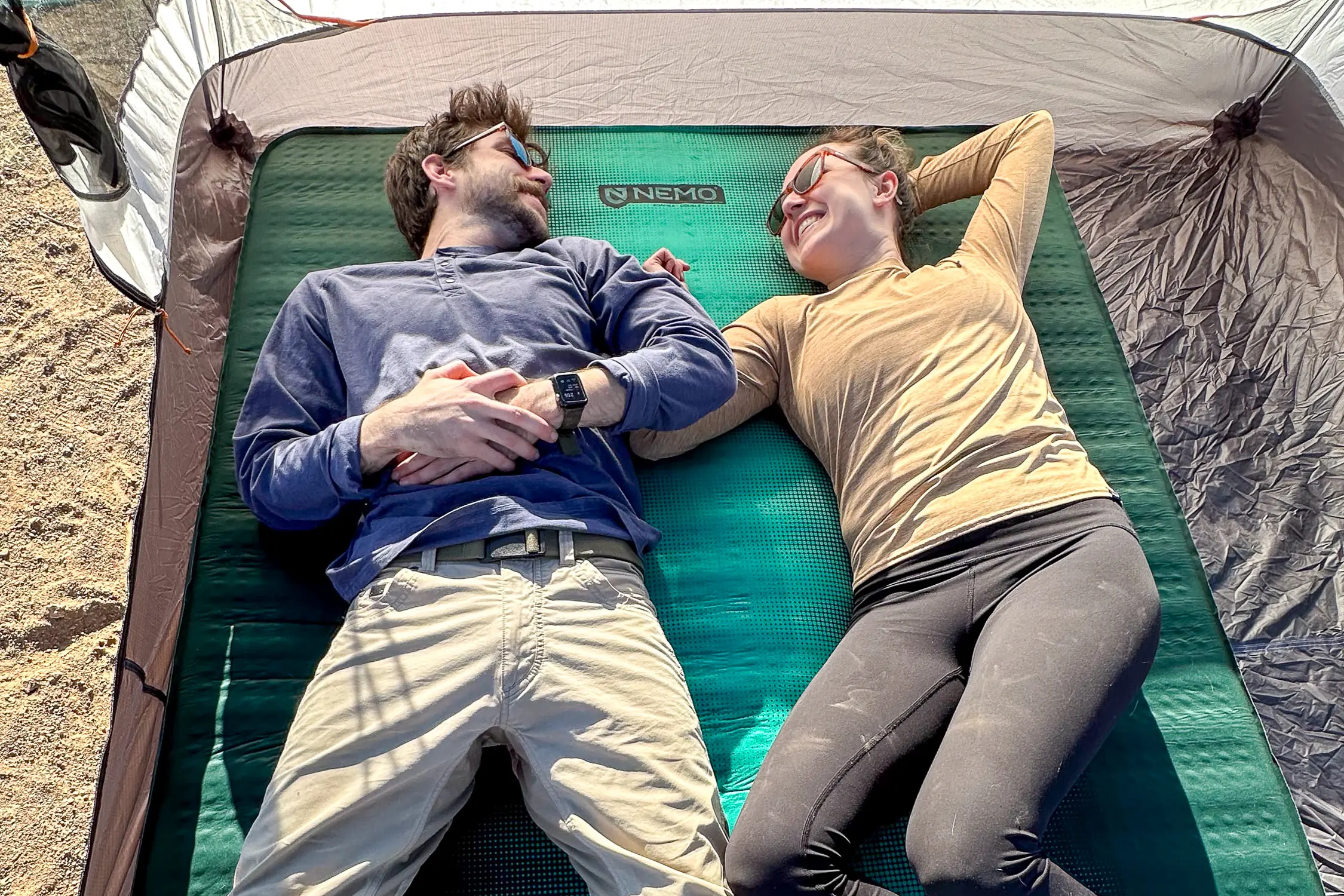



As your first defense against the cold, hard ground, a good sleeping pad is essential for a good night’s sleep.
Inflatable
Generally, the softest and cushiest sleeping pads are fully inflatable. Basically a huge rectangular balloon, inflatable sleeping pads will keep you completely off the ground and have the most mattress-like feel you can get when you camp. They’re also lighter and take up less pack space than foam pads.
There are a few trade-offs here. First off, inflatable sleeping pads are less durable than foam pads or combos. Any small prick in the pad can lead to a slow leak that will have you sleeping on the cold, hard ground all night.
Also, they’re notoriously noisy. Many campers report that it’s like sleeping on a bag of chips. If you’re a light sleeper and don’t want to sleep with earplugs, inflatable bags may be too loud for you.
They can also take a lot of time to set up, with several minutes of blowing into the valve.
That said, these still work great car camping and especially backpacking.
Closed-Cell Foam
On the other end of the spectrum is the closed-cell foam pad. This is a thin foam sleeping pad that folds up like an accordion or rolls up to save space. Due to their unique shape, they are also known as “egg crates.” If you ever see one, you’ll understand why.
Closed-cell foam pads are thin and light, but extremely durable and they provide consistent insulation. Because there’s no inflation involved, they are impervious to tears and punctures.
Some ultralighters will even cut down their foam pads to save weight. Also, they set up instantly — just lay them down, and you’re good to go. On the other hand, they don’t provide the cushioning of an inflatable, and they take up a lot of space.
You’ll often see them attached to the outside of a hiker’s pack. These are best for minimalist backpacking, and many campers will combine these with the other two to add a layer of insulation and pad protection.
Self-Inflating
Self-inflating sleeping pads are a compromise between the two. These are basically a closed-cell foam pad within an inflatable sleeping pad. They are quick to set up. And they provide a combination of the insulation you’ll find in closed-cell foam pads and the cushioning you’ll find in an inflatable pad.
They’re heavier and usually more expensive than foam pads and not as compact as inflatables. They are also susceptible to tears. Lightweight and durable, these are popular for thru-hiking. They’re also popular for winter camping trips thanks to their insulative properties.
Stay Warm
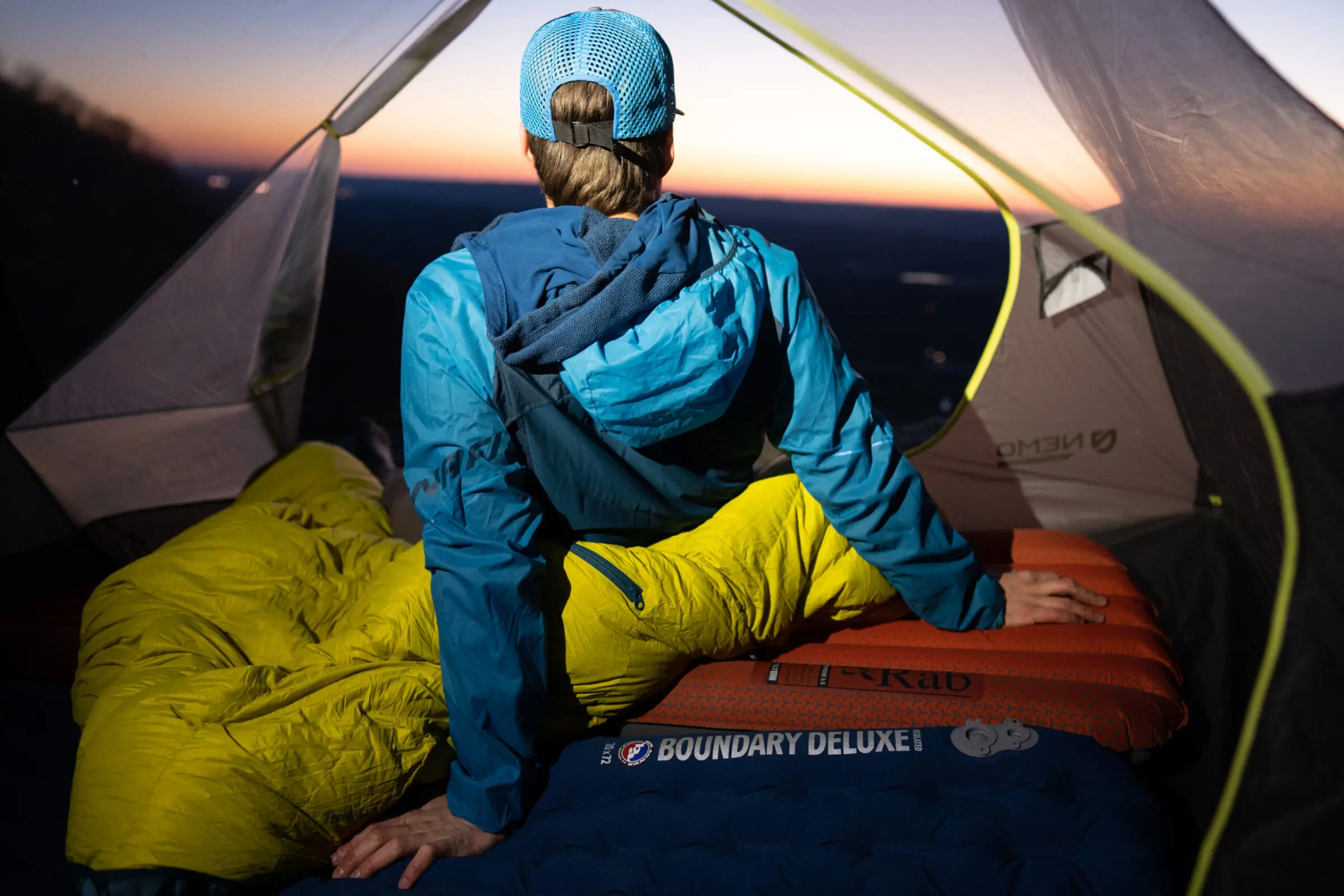



Few things feel better than getting warm and cozy in a sleeping bag on a cool night. So, be sure to get a sleeping bag that’s designed for the environment you’ll be camping in.
Sleeping bags come with a designated temperature rating. You can easily pick the right one for whatever location and season you decide to camp in.
If you tend to camp in cold weather, find a sleeping bag with a rating geared for colder temps. This also applies if you tend to sleep cold. Often, these will have venting options that let warm air out if you get too hot in your sleep.
Another option is to go to sleep with your socks and mid-layers on, and then slowly de-layer while you sleep. One tester who does this says a pile of warm clothes stuffed in the toebox “keeps my feet warm.”
Keep the Essentials at Hand
It’s a lot easier to get a good night’s sleep when you know where everything is. When you head to bed, make sure everything you need is close by and easy to find.
Store your headlamp by your head, preferably in your tent’s storage netting. That way, you can grab it when nature calls or if you hear something outside your tent that requires investigation.
Many tents have elastic mesh nets stitched into the inside. This helps organize smaller items in your tent like the aforementioned headlamp, multitool, spare socks, and anything else that will fit.
Also, store your boots just inside your tent’s entryway, or just outside it. That way, you can slip them on when you wander outside to make coffee. Ideally, your tent will have a vestibule so you can keep them outside without exposure to any potential rainfall.
Be Prepared
Getting wet in the middle of the night is a great way to ruin a restful evening. One common way to soak your sleeping bag is to get caught in a rainstorm without a rainfly. Another is to let condensation accumulate on the tent’s inner walls.
Rain is an easy fix. If there’s any chance of rain while you’re camping, set up your tent’s rainfly. Make sure that it’s cinched down to prevent the wind from blowing it away.
Condensation can be more difficult to deal with. However, a little care can go a long way in preventing moisture from building up inside your tent.
First, make sure that any wet clothes are outside the tent. Hang them to dry on lines or lay them out to dry during the night. Also, roll back your rainfly or leave your vestibule door open. The openings allow humid air and your exhalations to vent outside the tent.
Frequently Asked Questions
Absolutely. Camping pillows add a bit of comfort and help you get a better night’s sleep than a pile of clothes or a wadded-up jacket. The minimal investment of money, pack space, and weight is nothing compared to the comfort a pillow provides. It only takes one night of trying to sleep without one to realize the value that a good camp pillow provides.


Few things are more annoying to a camper than trying to keep your pillow on your sleeping pad. Waking up with your head on the ground and blindly groping around in the dark for a missing pillow is a great way to ruin your sleep at 1 a.m.
Thankfully, many camping pillows have features to prevent this. Some pillows are made with a contoured shape to mold to your head. Others have scalloped “wings” that help conform the pillow to your head and shoulders. This prevents it from squeezing out from under you while you sleep.
Some have texture on one side to increase friction and prevent sliding. This texturing often comes in the form of small rubber dots that add a bit of stickiness to help keep it on the pad. While it can help a bit, sleepers who tend to move around can still easily knock the pillow off the pad.
Some pillows include a more secure feature made up of elastic straps on the bottom of the pillow. The straps wrap around the sleeping pad to hold it in place.Others still are made to pair specifically with sleeping pads in the same brand. Often, these pads and pillows are designed to nest within a sleeve on the sleeping pad. In some cases, the pillows have hook-and-loop fasteners that are paired with similar fasteners on the pads.
Odors like campfire smoke and head funk can build up over time, eventually ruining a good night’s sleep. Be cautious when washing your camp pillow. Different pillows have different requirements when it comes to cleaning. Be sure to check your pillow’s packaging.
You may luck out and have a pillow you can toss in the washer and dryer when you get home. Others can be machine-washed but require hang-drying, so read carefully.
Most pillows require a bit more delicacy, particularly inflatable pillows. If you’re handwashing an inflatable pillow, make sure the valve is closed so water doesn’t get inside, and then immerse the pillow in soapy water.
You don’t need any special soap for this. Camp soap or laundry soap will work fine. Knead the pillow gently with your hands until it’s clean. Then rinse it with clean water to get the soap out and hang it to dry. Be careful not to tumble-dry inflatable pillows, as it can damage the air bladder.
The best camping pillow depends quite a bit on your personal sleeping preferences. If you’re a side sleeper, a thicker foam pillow is the better option. However, it will likely be heavier and take up more pack space.
If you’re trying to save weight and pack space, an inflatable pillow is a good idea. If you’re not sure what you want, look for a versatile pillow like NEMO’s Fillo line. It combines an inflatable bladder with slight padding on the face side, providing a mix of softness and packability. They also feature bungee cords on the back. This lets you roll up some clothes and stow them in the bungees if you want more loft.
If you’re new to camping and don’t know exactly what you want, think about what’s important to you and how much you’re willing to spend.
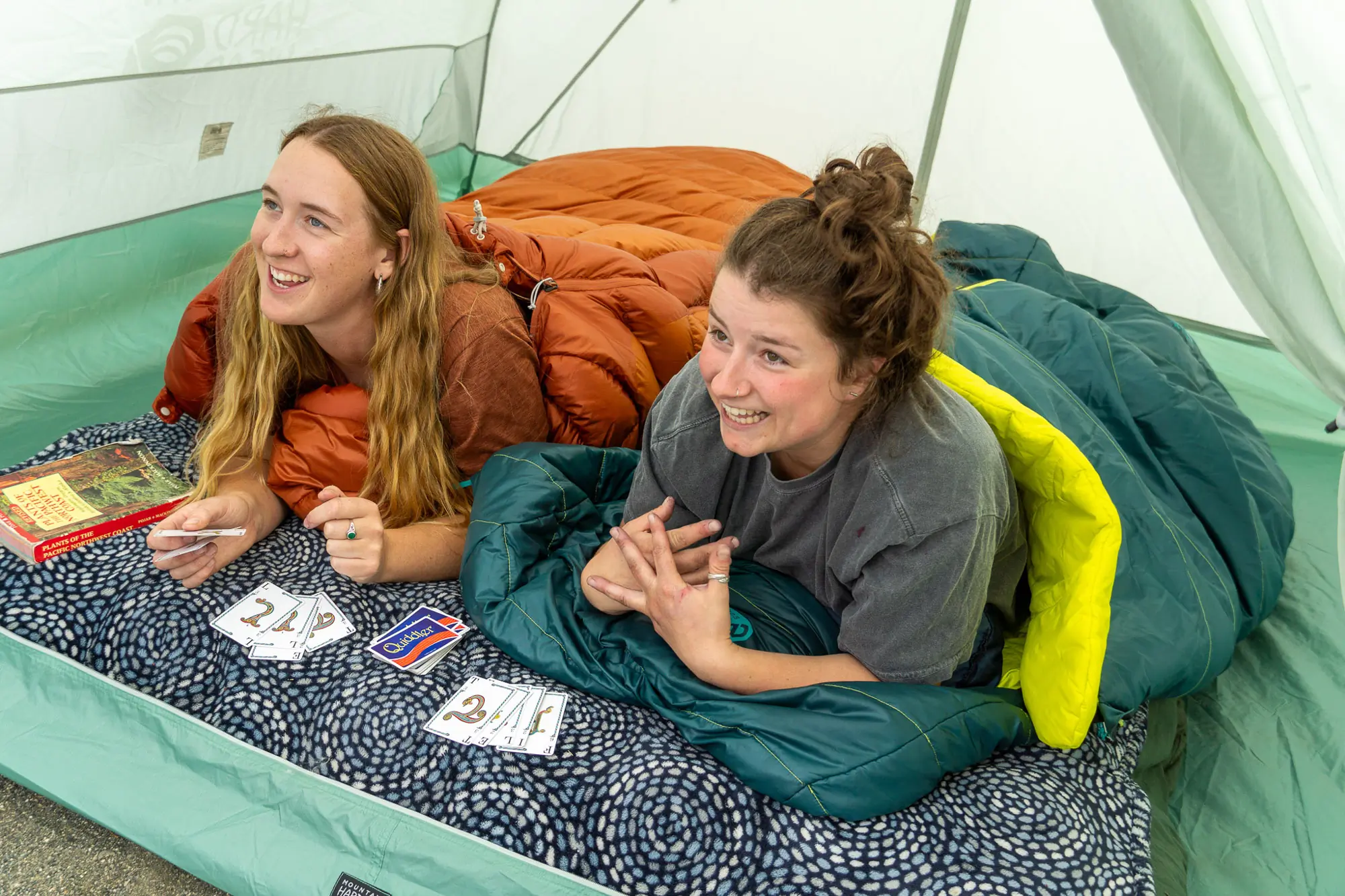

The Best Camping Sleeping Bags of 2025
From versatile camping bags to wallet-friendly picks, we’ve found the best sleeping bags for every use and budget.


The Best Camping Mattresses of 2025
From packable sleeping pads to ultracomfortable air beds, we tested and found the best camping mattresses and sleeping pads to fit every adventure and budget.
